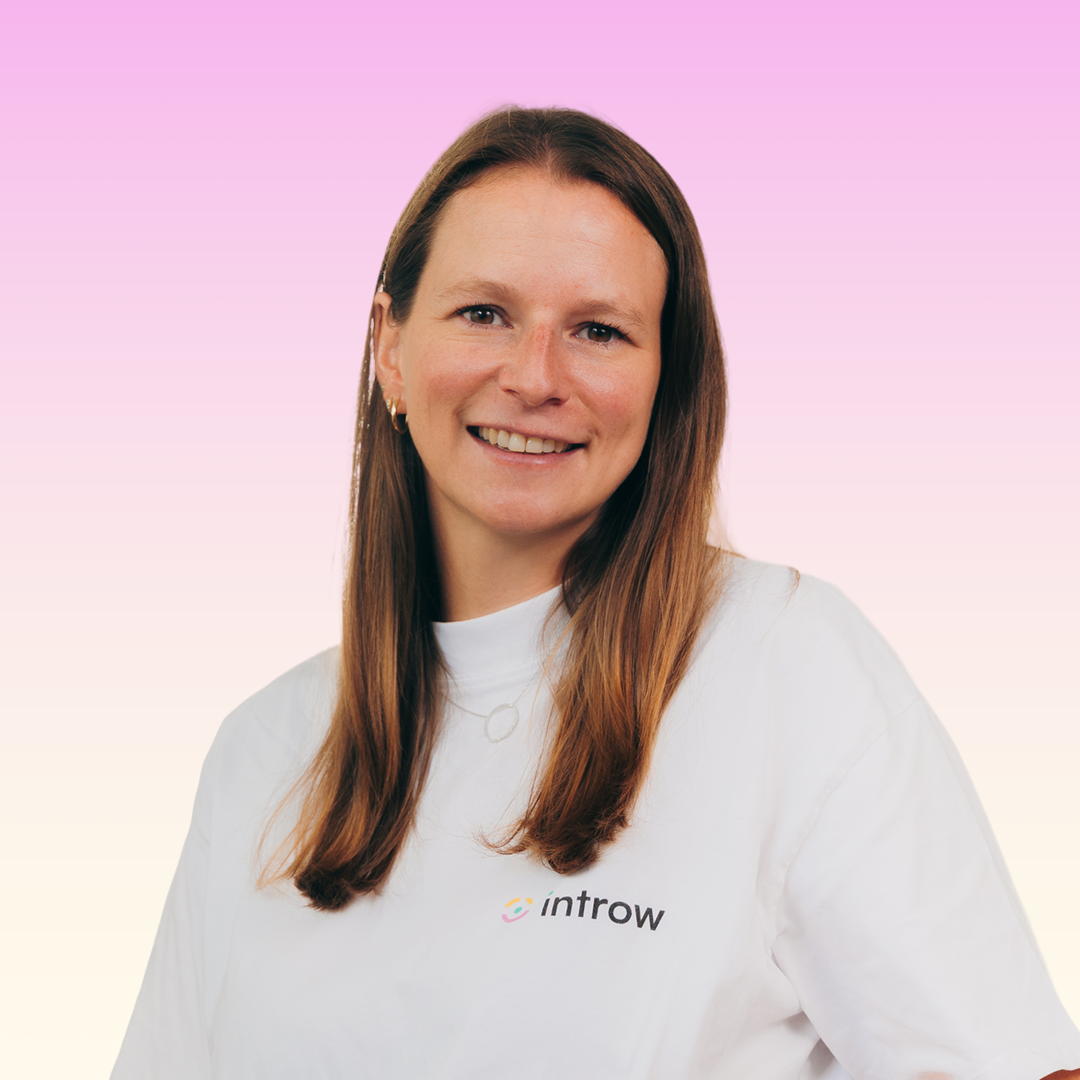Articles by Géraldine
Top 10 Partnership Trackers: Driving Co-Sell Revenue in 2026
Partnerships can be a lucrative revenue stream — when your business has the right tools for the job.
Indeed, many SaaS companies miss out on potential partner-driven revenue because they lack precise partnership tracking.
It's no secret that, in 2026, the traditional spreadsheet tracking is dead.
Manual updates, delayed insights, and fragmented data no longer cut it.
Instead, today's partner programs demand real-time visibility from overlap to close, ensuring every deal is tracked, attributed, and optimized for growth.
Modern solutions replace outdated spreadsheets with automated, CRM-integrated partnership tracking software, ensuring that partner-sourced revenue is captured seamlessly.
A precision-driven, real-time partnership tracker gives SaaS companies the edge by aligning sales teams, automating reporting, and enabling data-driven decisions.
With clear visibility into partner-influenced deals, businesses can maximize partner ROI, improve collaboration, and scale revenue faster.
In today's competitive landscape, partnership tracking isn't optional — it's essential for unlocking sustainable, repeatable growth.
What to Look for in a Partnership Tracking Platform
So, you know you need a modern partnership tracking platform.
But which features should you be looking out for?
Here are seven features that every strong partnership tracking platform should have in 2026:
- A CRM-native integration: Salesforce or HubSpot
- Lead/deal registration and auto-attribution
- Partner engagement metrics — for example: Slack or email syncs, partner activities log
- Forecasting partner-sourced and partner-influenced pipeline
- Ecosystem data integrations (Crossbeam)
- Real-time alerts and co-sell enablement
- Custom workflows by partner type (referral, reseller, tech, MSP)

10 Best Partnership Trackers to Use in 2026
Ready to revolutionize your partnerships by investing in a new partnerships tracker?
Here are ten top tools to consider.
#1 Introw (with Crossbeam Integration)

Introw is the most powerful PRM for modern SaaS companies — and its native integration with Crossbeam supercharges the entire partner revenue workflow.
Here's Why It's #1:
- Starts where your team lives: Salesforce or HubSpot
- Tracks every partner deal, lead, and engagement touch in real time
- Uses Crossbeam's account mapping data to identify overlapping customers and prospects across your ecosystem
- Tracks every engagement your partners have with content/sales presentations
- Tracks commissions in real-time
- All activity is tracked and visible to Partner Managers, RevOps, and CROs
Quick Feature Rundown:
- CRM-native lead & deal registration
- Real-time alerts via Slack and email
- Deal attribution and forecasting built into your pipeline
- Partner segmentation, enablement, and engagement tracking
- Modular workflows (referral, reseller, MSP, tech)
- Set-up in minutes — not months
Find out more:
🔗 Introw + Crossbeam Integration Overview
#2 PartnerStack

Referral and affiliate program software PartnerStack comes with some handy partner performance tracking features designed to help businesses recruit, track, and optimize partnerships effectively.
Quick Feature Rundown:
- Lead Monitoring
- CRM Integration
- Automated Attribution
- Performance Reporting
- Commission Automation
- UTM Tracking Support
- Fraud Protection
Pros: Commission automation, partner marketplace
Cons: Not ideal for co-sell motions or deep CRM integration
#3 Impartner
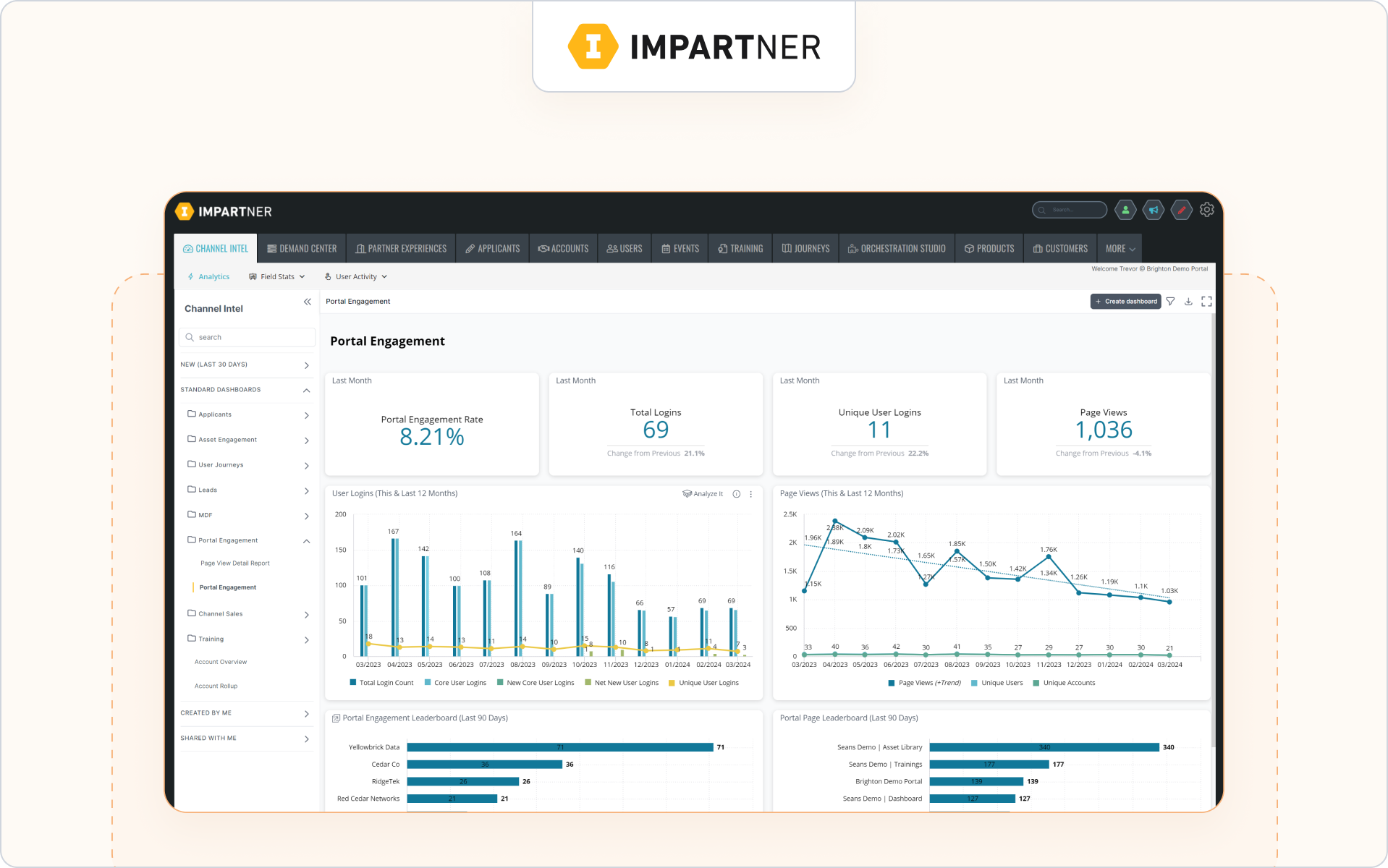
Impartner is a leading Partner Relationship Management platform designed to optimize and automate the entire partner lifecycle, enhancing collaboration and driving revenue growth.
Quick Feature Rundown:
- Partner dashboards
- Individual Partner Portals
- Portal workflows
- Role-based permissions
- Opportunity management
- Action tracking
- Lead management
- Partner performance reporting
- Partner engagement tools
- CRM integration
Pros: Comprehensive tracking, robust backend
Cons: Heavier set-up, limited CRM-native tracking
#4 Allbound (now Channelscaler)

Channelscaler (previously Allbound) helps leaders scale by winning partner mindshare, ensuring high levels of partner engagement and placing ease of doing business at the heart of your go-to-market channel strategy.
Quick Feature Rundown:
- Lead Management
- Opportunity Management
- Action Tracking
- Partner Performance Reporting
- CRM Integration
- Program Compliance Manager
- Business Planning Tools
- Journey Builder
- Analytics Studio
Pros: Great partner management, easy to use, good customer support
Cons: Limited customization
#5 ZINFI

ZINFI is a comprehensive Partner Relationship Management platform that streamlines partner engagement and performance tracking.
This platform puts a heavy focus on automation, empowering you to save time and money when managing your partnerships.
Quick Feature Rundown:
- Lead management
- Opportunity management
- Performance analytics
- Incentive management
- Partner portal
- Partner onboarding
- Partner training
- Deal registration
- Automated partner onboarding, training, marketing, selling, and performance tracking
Pros: Easy to use, strong partner management, good customer support
Cons: Some features are limited
#6 Kiflo

Partner Relationship Management platform Kiflo is designed to streamline partner engagement, growth, and success.
It offers customizable and automated tools that show users a visual representation of their partnerships.
Furthermore, Kiflo caters specifically to small to medium-sized businesses, providing a personalized approach to partner management.
Quick Feature Rundown:
- Lead and Deal Registration
- Real-Time Deal Tracking
- Dynamic Performance Dashboards
- Automated Partner Onboarding
- Customizable Certifications
- Content Management and Sharing
- Automated Reward and Incentive Management
- Comprehensive Analytics
- CRM Integration
Pros: Good customer support, strong partner management features
Cons: Integrations have limitations
#7 WorkSpan

WorkSpan is a Partner Relationship Management platform designed to enhance collaboration and drive revenue growth through strategic partnerships.
It provides a comprehensive ecosystem for co-selling, co-innovating, co-marketing, and co-investing, enabling organizations to optimize their partnership strategies effectively.
Quick Feature Rundown:
- Co-sell opportunity management
- Performance measurement
- Best-practice partnership planning templates
- Comprehensive reporting and analytics
- Real-time data sharing and collaboration
- AI-driven insights and recommendations
- Secure ecosystem access control
- Automated referral creation and sharing
- Customizable dashboards and metrics
- Integration with existing CRM systems
Pros: Strong partner management and collaboration tools
Cons: Steep learning curve
#8 LeadsBridge

LeadsBridge is a comprehensive integration platform designed to streamline lead generation and management processes by connecting various marketing and CRM tools.
Its unique value proposition lies in offering over 380 integrations.
These integrations include custom solutions tailored to specific business needs, ensuring seamless data synchronization and enhanced marketing efficiency.
Quick Feature Rundown:
- Lead sync
- Audience targeting
- Online-to-offline tracking
- Custom integration
- Real-time data syncing
- Lookalike audiences
- Platform-to-platform integration
- Lead nurturing
- eCommerce synchronization
Pros: Helpful customer support, thorough automation, seamless integrations
Cons: Initial set-up can be complex
#9 ZiftONE

Zift Solutions is a comprehensive Partner Relationship Management platform that streamlines channel management, enhances partner engagement, and drives revenue growth.
This software integrates marketing, sales, and learning processes into a single platform, offering personalized experiences for businesses and their partners.
Quick Feature Rundown:
- Partner explorer
- Tier Programs
- User achievements
- Partner groups
- Customizable partner portals
- Real-time analytics and reporting
- Seamless CRM integration
- Automated lead distribution
- Partner onboarding tools
Pros: Easy to use and good customer support
Cons: Limited customization
#10 Channeltivity

Channeltivity is a Partner Relationship Management platform designed to streamline channel management, enhance partner engagement, and drive revenue growth.
The software offers a comprehensive suite of tools — including deal registration, lead distribution, and partnership performance tracking — tailored to optimize channel operations for technology companies.
Meanwhile, its analytics and reporting suite, empowers leaders to make data-driven decisions and improve resource allocation.
Quick Feature Rundown:
- Deal registration
- Lead distribution
- Referrals and commissions
- Distributor management
- Partner dashboards
- Analytics and reporting
- Notifications and reminders
- Partner portal
- Training and certification
- Business planning
Pros: Streamlined partner engagement and deal tracking and responsive support to ensure customer satisfaction
Cons: Customization limitations
Why Introw + Crossbeam is the Best Partnership Tracking Stack in 2026
If you're ready to integrate account mapping into your PRM, consider Introw with Crossbeam.
So, how do the two platforms work together?
Introw leverages Crossbeam's overlap data to identify opportunities and instantly share them with your partners.
Essentially, Crossbeam finds the opportunity, and Introw then turns it into revenue.
This process is super simple too — one-click integration connects the partner overlap data to the actual pipeline.
What's more, Introw (with Crossbeam) syncs seamlessly into Salesforce or HubSpot, empowering you to manage your partner tracking process from inside your CRM.
The Introw-Crossbeam integration also enables co-sell motions with visibility, engagement, and forecasting.
And Introw is built for scale!
There are no portals, no spreadsheets, and no data silos here.

Conclusion
Today's partner programs live and die by what they can track.
Introw + Crossbeam is the only solution that handles account mapping, lead registration, engagement tracking, and forecasting — all in one flow
So, say goodbye to portal logins and spreadsheet chaos.
✅ Ready to track every opportunity and turn partnerships into pipeline? Book your personalized Introw demo
Partner Lifecycle Management: 8 Key Steps to Optimize Your Processes
Partner lifecycle management is how you turn potential partners into high performing partners — and keep them productive through every stage of the relationship. In 2026, the standouts treat the partner lifecycle as an operating system, not a campaign: a structured approach to recruiting partners, accelerating the onboarding process, establishing clear communication channels, monitoring partner performance, and renewing or exiting with professionalism. Done well, the partner management lifecycle delivers mutual benefits: expanding market reach, steadier pipeline, and long-term success for both sides. This guide lays out a practical playbook you can put to work across various stages of the partnership lifecycle, with notes on where a CRM-first partner relationship management stack (like Introw) simplifies the work.
What Is Partner Lifecycle Management?
Partner lifecycle management (PLM) is the structured management of the entire partner journey — from first contact through onboarding, activation, growth, renewal, or exit. Think of it as lifecycle management for two or more organizations working toward shared outcomes. In practice, PLM coordinates people, processes, and tools so partners receive the necessary resources at the right time: marketing materials when prospecting, sales tools at first opportunity, technical assistance at validation, and ongoing support after the first deal. The lifecycle of partner management commonly spans five stages: attract and qualify; onboard and enable; activate and co-sell; grow and retain; renew or exit. Whether you run a channel partner lifecycle management process, manage a services-led ecosystem, or blend in an affiliate program, the scaffolding stays the same — the emphasis and pacing change by motion and segment. A mature PLM function ties each stage to clear strategy, roles, and measurable outcomes so both companies see progress, not just activity.
Why Partner Lifecycle Management Still Matters in 2026
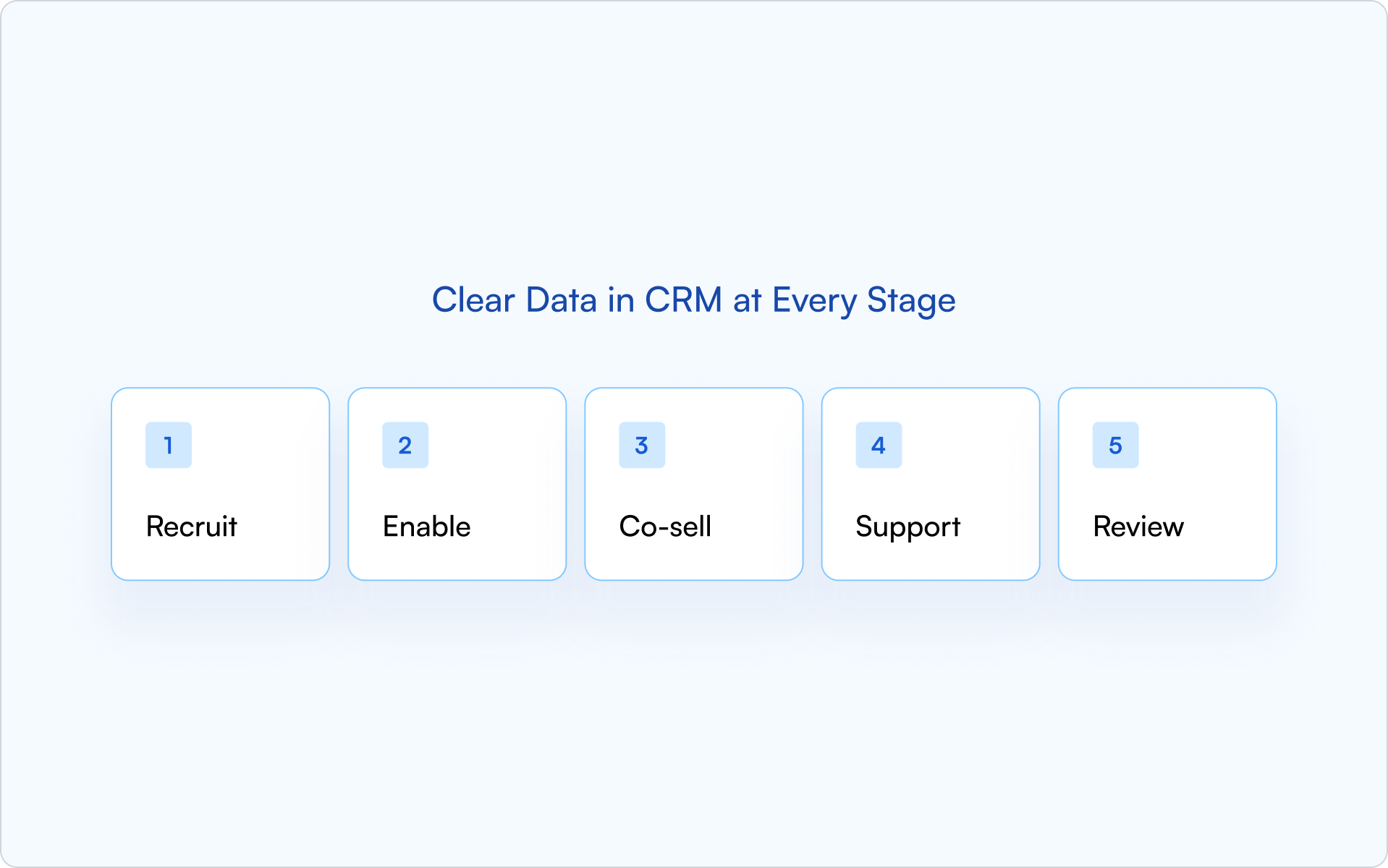
Partner ecosystems are broader and more specialized than ever: technology alliances, system integrators, services firms, and affiliate programs often collaborate on the same accounts. Buyers expect vendors and partners to move as one team, bringing complementary capabilities and credible local services. That expectation puts pressure on lifecycle management. If your stages are fuzzy or your data is scattered, you’ll feel it fast — slow onboarding, missed handoffs, and deals that stall because two companies aren’t on the same page. Effective partner lifecycle management fixes this by giving every stakeholder a clear map of the journey: how you’ll recruit, enable, co-sell, support, and review. It also anchors the relationship to business growth: shared goals, joint offers, and a cadence of regular reviews that turn activity into outcomes. When the lifecycle is visible inside your CRM, you can track performance, identify areas to coach, and allocate resources to the partners and plays that actually convert. The result is a healthier partner portfolio, stronger relationships, and a predictable route to revenue across new markets and existing accounts.
An 8-Step Framework for Effective Partner Lifecycle Management
Use this structured approach to align shared goals, streamline collaboration, and turn your partner portfolio into sustainable business growth across the full partner journey. Each step builds on the last and can be audited during quarterly reviews.
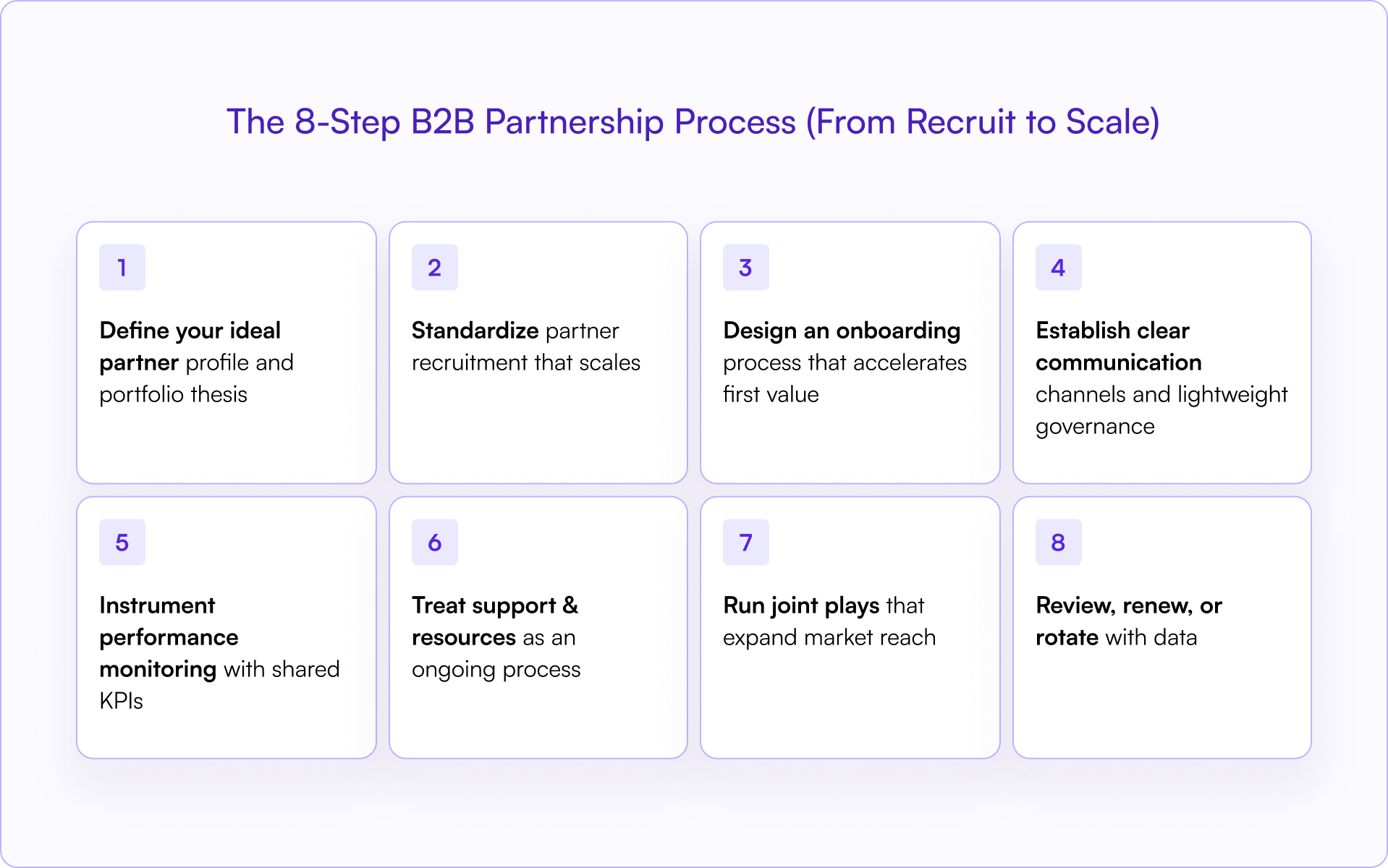
1) Define Your Ideal Partner Profile and Portfolio Thesis
Strong programs begin by naming the right partners up front. Build an ideal partner profile around business needs (industries, regions, customer base), complementary capabilities (integrations, services, routes to market), and the partner journey you can reliably support. Score prospective partners for strategic alignment, overlap with your respective customers, readiness to co-sell, and senior leadership sponsorship. Then write a simple portfolio thesis: how many partners per segment, which services matter, and where you’ll place early bets. This avoids the “many partners, little progress” trap and keeps resources focused where partnership strategies will pay off. Capture partnership goals, mutual benefits, and first-quarter actions in a one-pager for each target — it speeds quickly from interest to action and helps you maintain professionalism as conversations scale.
2) Standardize Partner Recruitment That Scales
Recruiting partners is a process, not a roadshow. Publish a short, public path for potential partners: a landing page, a qualification checklist, and clear owners for each stage. Mix outreach across your ecosystem — technology partnerships, system integrators, services firms, and (if it fits) a tightly scoped affiliate program. Make it easy to reach potential partners with transparent timeframes and who attends the first stage call. Share agendas and follow-ups with resources so candidates can evaluate fit without friction. Keep a “no-for-now” list and revisit quarterly; the market shifts, and new technologies or emerging trends can change strategic alignment. A repeatable recruitment motion preserves momentum, keeps the experience consistent across regions, and helps you identify the lifecycle of partner management signals that predict success early.
3) Design an Onboarding Process That Accelerates First Value
The handoff from recruiting to enabling is where many programs stall. Build a 30–60 day onboarding process with role-based, comprehensive training (seller, SE, marketer), current marketing materials, and a compact solution certification. Provide a starter kit: one-page positioning, a discovery guide, a 5-slide demo, and two co-brandable assets. Give partners the necessary resources to run their first motion without waiting on your team. Define roles and responsibilities, share a point-of-contact list, and set expectations for deal registration and response times. Close with a brief readiness check — who they’ll target, which sales tools they’ll use, and what success in the first quarter looks like. Well-run onboarding shortens time-to-first-deal, improves partner engagement, and sets the tone for a mutually beneficial relationship grounded in shared execution.
4) Establish Clear Communication Channels and Lightweight Governance
Clarity beats volume. Agree on clear communication channels (email/Slack) and a simple governance rhythm: weekly pipeline syncs during activation, monthly operating reviews, and a quarterly strategy checkpoint. Document owners on both sides — a partner manager, sales lead, marketing lead — and write how to escalate blockers. Keep meetings short and focused on progress, not status. Encourage both organizations to share insights from the field so you can adjust messaging and plays quickly. Lightweight governance helps many partners move in parallel without creating bureaucracy, and it’s a key element of channel partner lifecycle management where multiple vendors may touch the same customer. When communication is structured and visible in the CRM, teams stay aligned and issues surface early, before they threaten deals.
5) Instrument Performance Monitoring With Shared KPIs
You can’t manage what you can’t see. Decide on a short list of KPIs that actually describe partner performance: sourced pipeline, acceptance time for deal registrations, stage conversion, win rate, and adoption of integrations or services. Add health signals like content usage, meeting cadence, and response times. Review data where the work happens — your CRM — so you can track performance without spreadsheets, then coach to specifics: where a partner stalls, which assets work, and which markets convert. Segment reports by various stages of the partner lifecycle so you can identify areas to improve (e.g., partners strong at sourcing but weak at validation). Shared dashboards and regular reviews turn conversations from opinion to plan and spotlight high performing partners for investment.
6) Treat Support and Resources as an Ongoing Process
Effective PLM doesn’t end after onboarding. Partners need ongoing support that matches their maturity: faster answers during early co-selling, deeper enablement as deal sizes grow, and guidance on industry regulations or security for complex accounts. Maintain a living catalog of additional resources — case studies, security briefs, ROI models — and update them as products evolve. Ensure partners receive timely technical help during proofs and clean, co-owned mutual action plans. Give customer success a clear role in the partnership lifecycle so joint wins become references and renewals. The goal is a steady experience that reinforces trust and keeps engagement high across the lifecycle of partner management.
7) Run Joint Plays That Expand Market Reach
Activation sticks when both sides see pipeline. Package one or two joint plays aimed at new markets or specific use cases: a webinar with a follow-up sequence, a field workshop for an account list, or a services-plus-product bundle. Align on routes to market, lead flow, and attribution so mutual benefits translate into revenue growth and brand visibility. Combine complementary capabilities — a cloud solution with a compliance specialist, for instance — to strengthen the business relationship and create partnership success with clear offers. Share wins publicly; it motivates teams and gives the next partner a model to follow. Over time, a few proven plays will do more for business growth than a shelf full of unused assets.
8) Review, Renew, or Rotate With Data
End each quarter with a concise review: what worked, what lagged, and one change to test. Decide whether to renew, expand scope, or pause. If you renew, raise the bar with new partnership objectives and a larger target list; if you exit, keep a documented handover and protect customer experience. A respectful close protects your reputation and may reopen doors later. This adaptive management approach keeps your partner portfolio healthy, aligns investment with results, and ensures your PLM remains a comprehensive approach — not a set-and-forget checklist.
Metrics & Dashboards That Keep You Honest
A clean measurement layer is the difference between anecdotes and accountability. Tie the channel partner lifecycle management process to a handful of outcome metrics (sourced pipeline, bookings, cycle time, win rate, expansion on joint accounts) and a few leading indicators (registrations responded to within 24 hours, mutual action plans created in first meeting, enablement completions). Track by stage of the partner management lifecycle so you can see where partners speed quickly or stall. Layer in program health signals — active partners by segment, ramp time, content adoption — so you can plan capacity and resources. The goal isn’t a flashy BI stack; it’s a dashboard you trust enough to make decisions weekly. When your key takeaways are visible to the key stakeholders who own sales, marketing, and success, the program improves continuously instead of once a year.
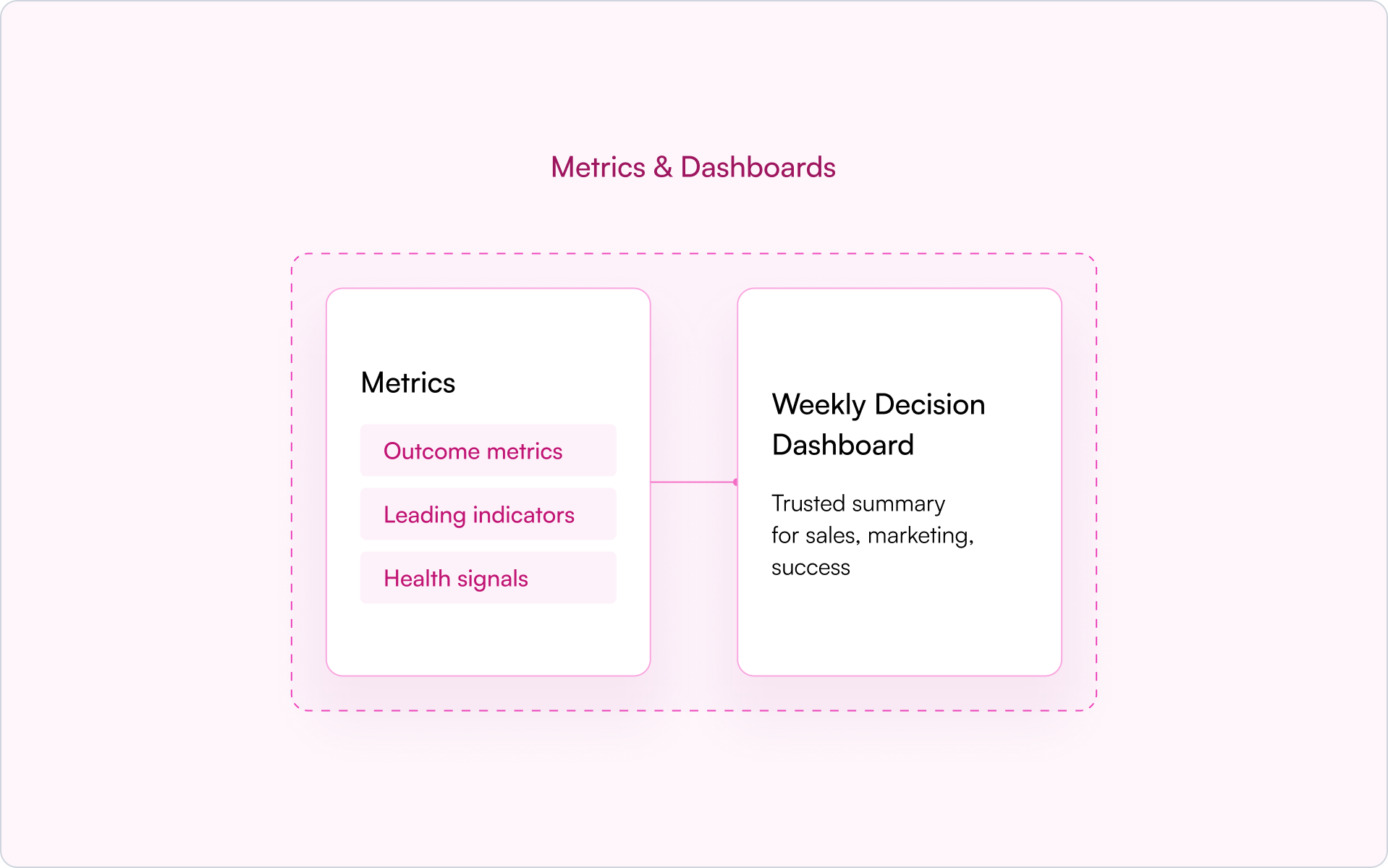
Conclusion
Partner lifecycle management is a comprehensive approach to turning partnership intent into durable results. Define who you’ll work with, start them quickly, keep communication and governance light but consistent, measure what matters, and renew relationships with confidence — or close them cleanly. When you operate the lifecycle inside your CRM and design for adoption, you get mutual success: stronger collaborations, predictable pipeline, and customers who experience coordinated service from first meeting through renewal. If you want the mechanics to feel easier, consider Introw’s CRM-first PRM to keep the work simple and the results visible.
12 Strategies for Building Effective Partner Ecosystem in 2026
In 2026, traditional, linear partner programs simply aren’t cutting it.
Instead, SaaS teams need to build modern, collaborative partner ecosystems with multi-directional partnerships.
From co-creation and shared growth opportunities to innovations and integrations, successful partner ecosystems have the potential to become a significant revenue stream for any SaaS brand.
Read on for our 12 impactful strategies for building an effective partner ecosystem fit for 2026.
What is a Partner Ecosystem? (2026 Definition + Key Terms)
A partner ecosystem is an interconnected network of companies that collaborate to deliver better value to customers.
So what’s the biggest difference between more traditional, linear programs like channel programs and alliances, and modern partner ecosystems?
Channel programs work inside a structured, transactional framework.
Within a channel program, partners (such as reseller partners, VARs, and distributors) sell or resell your product, incentivised by discounts and margins.
An alliance, on the other hand, refers to a strategic partnership between two or more companies (often at enterprise-level) to jointly pursue opportunities.
This could mean co-developing solutions or launching into new verticals together.
So, what is a partner ecosystem?
Broader and more modern, ecosystems are collaborative and, vitally, multi-directional, putting a sharp focus on co-creation, integrations, and shared growth opportunities.
These ecosystems encompass channels, alliances, integrations, resellers, service partners, technology vendors, consultants, and influencers, with collaborations occurring across multiple partner types.
So, what is an ecosystem partner?
An ecosystem partner is defined as any external company that actively contributes to your ecosystem.
Their role goes far beyond transactions; for instance, they might contribute by integrating, co-marketing, implementing, or influencing customers, as well as selling.
They provide added value to both your SaaS business and your customers through their expertise, services, or integrations, helping to expand your solution’s reach.
These modern partner ecosystems typically outperform traditional SaaS partner programs because they’re designed for flexibility, collaboration, and delivering value to customers, rather than just transactional sales.
The Business Case: Benefits of a Partner Ecosystem
Why should you build a partner ecosystem?
Here are four of the biggest benefits of taking this approach.

- Pipeline and Reach
A robust partner ecosystem significantly enhances the number of trusted voices and channels that bring your solution to market.
This helps to expand your brand’s reach and keep your pipeline looking very healthy.
Indeed, getting this right should lead to more deal sources, shorter sales cycles, and improved pipeline diversity.
Meanwhile, partners help you to launch in new geographical markets faster and specialise in more verticals.
- Faster Innovation
Your partner ecosystem will also open up more avenues for co-creation, experimentation, and feedback than more traditional programs.
It empowers you to tap into external creativity, quickly enter new verticals, experiment at scale, launch plug-and-play solutions, and develop faster feedback loops —all of which increase the speed at which innovation occurs.
And faster innovation keeps you at the forefront of the market, which is crucial in a fast-moving industry like SaaS.
- Elevated Customer Experience
Building a partner ecosystem enhances the customer experience by granting customers access to more value, choice, and support than the SaaS company could deliver alone.
Furthermore, by their very nature, ecosystems deliver integrated offerings, allowing you to provide a seamless workflow rather than a fragmented stack.
This significantly reduces friction throughout the customer experience.
- Lower CAC and Shared Risk
When you’re supported by a robust partner ecosystem, your customer acquisition cost (CAC) should drop significantly.
With a wide variety of partners generating warm leads from their own customer bases, you reduce the amount your business needs to spend on tactics like cold outreach and ads.
Furthermore, co-marketing means you share costs with your partners, while customers are more likely to buy when a trusted partner recommends your SaaS, shortening sales cycles.
Of course, you’re also spreading out the financial and operational risks by operating from within an ecosystem, from go-to-market investments to innovation risks.
Types of Partners in a Modern Ecosystem
In channel partner mapping, partners are typically classified primarily by their role in reselling or distributing your SaaS product, but in a modern ecosystem, we take a network-based view of all partner types that contribute to customer success and growth.
So let’s take a closer look at the types of partners that make up a modern ecosystem.

- Technology partners/integrations connect your SaaS to complementary platforms and tools, creating seamless workflows that make your product more valuable and harder to replace.
- Resellers purchase your SaaS at a discount and then sell it to end customers.
- Value-added resellers (VARs) bundle your SaaS solution with services, customization, or other complementary products, tailoring the solution to meet specific customer needs.
- Managed service providers (MSPs) deliver your SaaS as part of a managed service package. For example, they might take over IT, security, or operations for customers who prefer outsourced solutions.
- Training and certification providers offer guidance to help business leaders and employees build skills and knowledge around your product.
- Referral partners introduce you to potential customers, helping you generate warm leads rather than selling directly.
- Solution/service partners are consulting firms or service providers that implement, customize, or optimize your SaaS, ensuring customers see value faster and more effectively.
- Independent software vendors (ISV partners) build complementary apps or features to extend your SaaS.
- Alliances comprise two or more companies in a strategic partnership aimed at expanding their market opportunities.
- Co-innovation partners actively collaborate with you to create new solutions, products, or features.
Top Ecosystem examples
- Salesforce built the AppExchange marketplace, where ISVs and partners create apps that integrate directly with Salesforce.
- Amazon Web Services (AWS) has cultivated a partner network that supports tens of thousands of consulting and tech partners who help customers adopt AWS at scale. Meanwhile, AWS Marketplace enables SaaS vendors to sell cloud-native solutions directly to enterprises.
- HubSpot is known for its partner ecosystem of agencies, consultants, and ISVs. Agencies provide inbound marketing support powered by HubSpot, while the HubSpot App Marketplace hosts integrations with hundreds of SaaS tools.
12 Strategies for Building an Effective Partner Ecosystem in 2026
Is it time to build your partner ecosystem and take your SaaS brand to the next level?
Read on for our 12 essential B2B partner ecosystem strategies for 2026.

1. Map Your Ideal Ecosystem & Define the ICP
Start with a partner ecosystem mapping exercise – you’ll thank yourself down the line.
This mapping exercise should help you to:
- Clarify partner roles
- Prioritize investment
- Reduce duplication and gaps
- Visualize how partners interact to deliver end-to-end customer solutions
- Allocate resources efficiently
- Strategically scale partner engagement
Start by identifying high-value partner types, industries, and geographies.
Then visualize interconnections, so you understand how partners complement each other and deliver end-to-end customer solutions.
For optimal results, you should also dedicate time to developing your ideal customer profile (ICP).
Analyze your top-performing accounts to identify common traits, pinpoint their pain points and needs, segment the list by relevant criteria such as location or tech stack, and determine the decision-making roles within those businesses.
It’s vital to use data to define and refine your partner ecosystem ICP, for example, prioritising partners based on their impact on pipeline, adoption, and customer success.
2. Prioritize Ecosystem Fit Over Volume
While it can be tempting to take on every potential partner that comes your way, resist signing every logo and prioritize quality over quantity.
Remember: you need to be strategic about this.
Your business doesn’t necessarily need hundreds of partners to grow – in some cases, five or six well-chosen partners can be more effective.
So, how do you know which partners to sign and which to avoid?
First, create clear partner profiles. This provides clarity on roles, enables targeted enablement, reduces friction between partners, and simplifies onboarding and management of new partners.
And vitally, it also gives you a sense of whether and where each potential partner would fit within your ecosystem.
You should also investigate the potential value exchange of a partnership to see if it’s worth bringing a company on board.
Look at what the potential partner would contribute (for example, their reach, expertise, or technology), and what they gain in return (such as revenue growth, leads, product advantages, or market credibility).
3. Build Trust with Transparent Onboarding & Enablement
Don’t underestimate the importance of a robust onboarding and enablement program when it comes to laying the foundations for ecosystem success.
Our ten essential strategies for partner onboarding and enablement are as follows:
- Start pre-onboarding prep before the contract
- Segment and personalize the onboarding experience
- Automate welcome and kickoff communications
- Deliver role-based enablement and certification
- Make deal registration fast and frictionless
- Provide ‘always-on’ resource access
- Assign dedicated onboarding support
- Run automated progress and activation tracking
- Schedule early wins and QBRs
- Gather feedback and continuously optimize
Partner ecosystem platform Introw includes a multitude of features that make building an effective onboarding and enablement program much easier, including:
✅ CRM integration
✅ Automated onboarding
✅ Partner enablement flows
✅ Real-time tracking
✅ Self-serve resources
4. Centralize Communication and Engagement
When you’re managing multiple partners, it’s crucial to prioritize communication and engagement.
Failure to master both of these disciplines can see your partnership program flounder and falter, and your business miss out on opportunity after opportunity.
When it comes to communication and engagement, it’s vital to meet partners where they’re working.
And this means launching and maintaining several communication channels. For example, you might establish three main channels: email, Slack, and your partner portal.
Save time and improve consistency by using your PRM to set up automated communication flows, including welcome messages, milestone reminders, and enablement updates.
Also, remember to track engagement levels and adjust your strategy as needed.
5. Enable Self-Service and “Always-On” Resources
Reduce friction within the partnership experience by enabling self-service and ‘always-on’ resources.
Using on-demand knowledge bases, self-service portals, and/or enablement content hubs empowers partners to engage with you at their leisure.
In 2026, it’s vital to track your partners’ content usage to improve the ecosystem consistently.
Introw, for example, provides analytics for every engagement metric – track asset views and downloads to find out which documents, resources, and deals your partners are engaging with, and how frequently they’re doing so.
Then, analyze this data to optimize your partner portal and resources effectively.
6. Collaborate on Go-to-Market (GTM) Motions
Collaborating on go-to-market motions is often one of the biggest payoffs of a strong partner ecosystem.
Whether you’re launching joint campaigns, co-producing events, co-selling, or creating bundled offerings, there are plenty of attractive benefits to taking this approach.
It allows you to expand market reach with a lower CAC cost, strengthens your customer value proposition, and can lead to a shorter sales cycle due to an increased trust factor.
Furthermore, GTM motions should also lead to better operational efficiency and shared insights.
To achieve this, be sure to share your pipelines, leads, and success metrics when collaborating on such initiatives.
7. Automate Deal Registration, Attribution, and Reporting
Automating deal registration, attribution, and reporting is one of the most impactful actions you can take when constructing your ecosystem.
Here’s why.
It eliminates channel conflict by ensuring partners don’t compete with each other (or with your sales team) for the same opportunities, and it provides accurate attribution, which means rewards are fairly distributed.
From your perspective, the real-time visibility and forecasting that automatic registration enables doesn’t hurt either!
And, as with most administrative tasks, automating deal registration, attribution, and reporting will save time for all parties involved, with no manual entry required.
You should also look for a partner relationship management tool that automatically syncs this data to Salesforce, HubSpot, or your preferred CRM.
Introw delivers CRM-native deal registration with a no-code form builder, which means that forms can be embedded in partner portals or external pages via URL, with no portal login required.
Each form submission is then automatically mapped back to your CRM and synced with Salesforce or HubSpot in real time.
Attribution is also automated, with partner revenue attribution tagging synced to your CRM, as well as automated deal notifications.
When it comes to reporting, lean on Introw’s real-time dashboards, which deliver up-to-the-minute revenue insights and partner engagement analytics.
Crucially, in a partner ecosystem, Introw also offers role-based visibility, allowing each stakeholder to access only the relevant dashboards.
8. Run Data-Driven QBRs and Partner Reviews
When it comes to maintaining and reinforcing the strength of your partner ecosystem, data-driven QBRs are non-negotiable.
It’s absolutely crucial to use engagement and revenue data to inform these sessions, rather than relying solely on anecdotes.
Not only does this enable you to align on what’s working (and what’s not), but partners want to see reliable, data-based results – in 2026, no one wants to be working off ‘gut feel’.
You must also conduct regular partner reviews to identify your top performers, as well as those who are at risk.
This way, you can fairly reward top performers and hold those who are not pulling their weight accountable.
It’s also beneficial when considering who to include or partner with on future initiatives within the ecosystem.
9. Scale with Segmentation and Personalization
Most partner ecosystems comprise a diverse range of businesses, which means you need to segment and personalize your approach to engage with them effectively.
There are many different ways to approach segmentation.
Depending on your circumstances and your goals, you might want to segment partners by:
- Partner tier
- Region
- Solution
- Engagement level
- Partner type
- Performance
- Vertical
You can then automate personalized communications and incentives by segment, which enables you to scale your ecosystem much faster than you would have been able to in the past.
10. Build Feedback Loops and a Partner Advisory Board
Feedback loops can be the difference between helming a thriving partner ecosystem and complete disengagement.
Remember – your partners are on the frontline, hearing customers’ questions, objections, and feedback.
By establishing a structured feedback loop, you ensure that these insights flow back into product, marketing, and sales enablement, where they can actually make a difference.
Furthermore, feedback loops tied to metrics such as deal registration rates and co-sell win rates reveal what is working and what isn’t.
Meanwhile, establishing a partner advisory board gives strategic partners a seat at the table in shaping your ecosystem, making them co-owners of the initiative and ensuring they feel valued and heard.
The most effective feedback technique for you will depend on the makeup of your business and ecosystem, but it could include regular partner surveys, joint roadmaps, and open office hours.
11. Foster a Collaborative Ecosystem Culture
In more traditional schemes, partners have often been siloed.
But in 2026, we know that fostering a truly collaborative ecosystem culture brings significant benefits to all parties involved.
These benefits include faster business growth, lower CAC, expanded market reach, stronger partner relationships, improved customer experience, more innovation, and an overall strategic advantage.
Cultivate this vibe by enabling partner-to-partner introductions and sharing forums.
You can also highlight joint wins with case studies and public acknowledgement across the ecosystem’s communication channels.
12. Continuously Optimize: Iterate and Innovate
From A/B testing campaigns to regular reviews of partner data, you must continuously optimize your partner ecosystem for best results.
Tracking vital metrics empowers you to sunset low-performing partners before they become a drain on your ecosystem, and invest in ‘next gen’ ecosystem plays.
Of course, you want to make tracking ecosystem metrics and analysing data as easy and effective as possible – and that’s where Introw comes in.
This sophisticated PRM incorporates real-time, user-friendly partner performance dashboards, while centralized visibility makes it super easy to get a snapshot of what’s going on at any moment.
Furthermore, its workflow automation capabilities include engagement-based alerts and automated deal updates, ensuring you’re always in the loop.
Challenges of Managing a Modern Partner Ecosystem (and How to Overcome Them)
With a broad range of partners and rapidly evolving technology, managing a partner ecosystem comes with its own set of challenges.
Here are the pitfalls to be aware of:
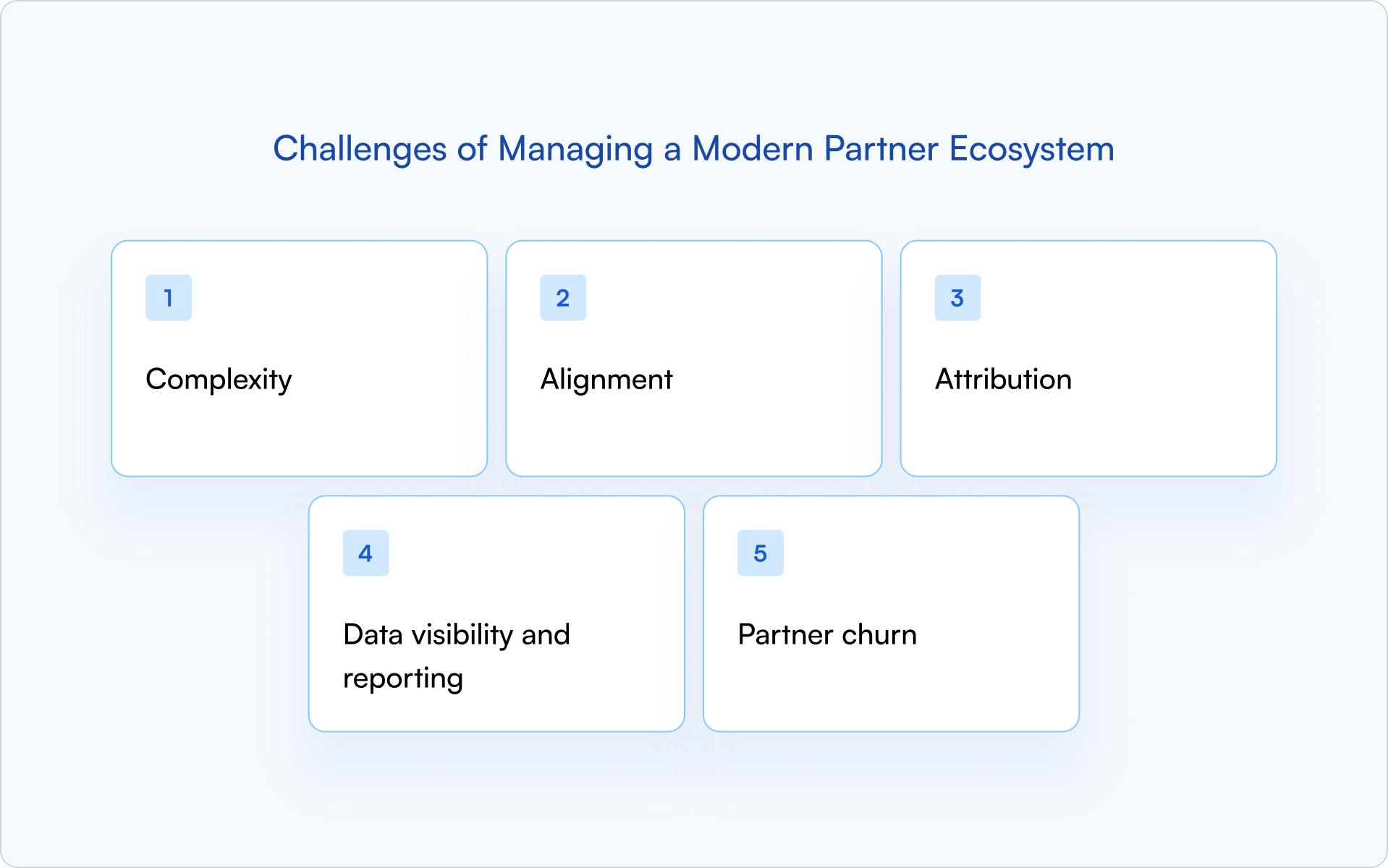
- Complexity: Staying on top of multiple motions, partner types, and geographies can be tricky, as each requires unique enablement, workflows, and tracking that quickly overwhelm manual processes.
- Alignment: Keeping all your partners aligned behind shared goals is difficult when everyone has different priorities and circumstances.
- Attribution: Accurately connecting activity to revenue can be super complex (especially without the right tech). This can make it hard to prove impact, reward partners fairly, or justify ecosystem investments.
- Data visibility and reporting: Without centralized, real-time insights, leadership and partner managers lack the visibility needed for a thriving ecosystem.
- Partner churn: If partners feel under-supported, misaligned, or unrecognized for their contributions (due to the above challenges), they will most likely disengage from your program and shift their focus to competing ecosystems.
The key to overcoming these challenges lies in your tech stack.
Indeed, investing in the right CRM-native platform and the right automation tools can prove something of a silver bullet for partner ecosystem challenges.
Look for software that:
✅ Streamlines complexity with standardized workflows
✅ Keeps goals aligned through transparent incentives
✅ Automates attribution for fair credit
✅ Delivers real-time analytics directly into your CRM
✅ Creates a smooth partner experience that reduces churn
The Role of Technology: Partner Ecosystem Management Platforms & Tools
So, when it comes to securing the optimal tech for your partner ecosystem, what exactly should you be looking for in a PRM?
There are three core must-haves:
- CRM integration
- Off-portal communications
- Real-time analytics
But if you want to build a partner ecosystem that will become a significant revenue stream for your SaaS business, you’re going to want more than a traditional partner relationship management system can offer.
Instead, look for a comprehensive partner ecosystem management platform like Introw.
Building on the core must-haves outlined above, Introw is:
✅ CRM-first: Introw is natively integrated with Salesforce and HubSpot, so deal registration, attribution, and reporting all flow directly into your CRM.
✅ Scalable: Templates, auto-segmentation, and workflow automation make it easy to manage hundreds or thousands of partners without manual tasks piling up.
✅ No-login-required: Partners can register deals, access assets, and receive updates via forms, email, or Slack without needing to log into a separate portal.
✅ Built for SaaS ICP: Introw is tailored for the SaaS industry, which means it delivers handy features for modern SaaS go-to-market strategies, such as account mapping, revenue attribution, and co-sell workflows.
The Future of Partner Ecosystems: Trends to Watch in 2026
SaaS is an incredibly fast-paced industry, so when building your partner ecosystem, it always pays to have one eye on the future.
Here are four rising ecosystem trends to watch out for in 2026 and beyond:
- AI-Powered Partner Matching, Automation & Analytics
AI will increasingly be used to help identify the right partner opportunities, optimize workflows, and surface insights.
- Embedded Integrations & API-First Ecosystems
Seamless technical integrations between partner products will become the norm.
This means that, before long, customers will expect access to end-to-end solutions without friction.
It should also drive up adoption stickiness.
- Verticalization & Specialization Of Partner Networks
We can also expect partners to increasingly focus on specific industries or niches.
From the perspective of SaaS companies, this should enable the development and delivery of more tailored solutions, thereby achieving stronger alignment with customer needs.
- The Rise Of ‘Ecosystem-As-A-Service’ Platforms
Platforms that provide turnkey partner management, automation, and enablement tools will become increasingly popular as ecosystems mature into a significant revenue stream.
These platforms will vastly simplify ecosystem operations, allowing SaaS companies to build, scale, and optimize their networks faster.
Why Introw Is The Future Of SaaS Partner Ecosystem Management
Ready to take your partner program to the next level with world-class ecosystem management?
Here’s how Introw – an advanced partner ecosystem management tool tailored for SaaS – can help.
✅ Unified partner management, engagement, and reporting in your CRM: All partner data, deal activity, and engagement metrics live within your CRM, giving teams a single source of truth and eliminating silos.
✅ Automation at every step: From onboarding and engagement to deal registrations and QBRs, routine tasks are streamlined and triggered automatically. This frees up teams to focus on high-value activities while keeping partners engaged and productive.
✅ Off-portal experience = frictionless for partners: Partners can register deals, access assets, and receive updates without logging into a separate portal.
✅ Role-based dashboards: Each revenue leader accesses their own dashboard, which displays the data most relevant to them.
Take the first step towards a thriving partner ecosystem today – request an Introw demo here.

Conclusion
Old-fashioned, siloed partner programs won’t do much for your business in 2026, but a strategic partner ecosystem could establish your brand as a major industry player.
Remember – to win with a partner ecosystem in 2026, you need to put a laser-sharp focus on automation, measurement, and collaboration.
➡️ Audit your ecosystem strategy, adopt CRM-native tools, and start scaling with Introw
Partner Onboarding Checklist: All You Need to Get It Right in 2026
Are you disappointed in your SaaS company's partner program?
You’re not alone. Most companies have confusing onboarding flows, scattered resources, and no clear path to a partner’s first deal. The result? Partners feel lost, engagement drops, and it takes far too long to see any real revenue from your partner program.
Good news: you can fix these problems with a channel partner onboarding process.
Keep reading to learn why B2B partner onboarding matters, how to onboard new partners successfully, and tools to dramatically improve partner performance.
Why B2B Partner Onboarding Matters More Than Ever
First impressions define relationships.
If a partner thinks your SaaS company is unorganized or unsupportive at the beginning of your partnership, they'll keep thinking it until the partnership ends.
An effective onboarding process will improve the partner journey from day one. How so? By ensuring each partner has the training, tools, and support they need.
Put simply, a strong onboarding process will increase partner engagement, boost deal velocity, and reduce churn—all of which will lead to higher revenue numbers.
A 10-Step Channel Partner Onboarding Checklist for 2026
How do you build a partner onboarding program that works?
While we can't make guarantees, the 10-step partner onboarding template below will give the best chance to succeed in this area. Let's dive in…
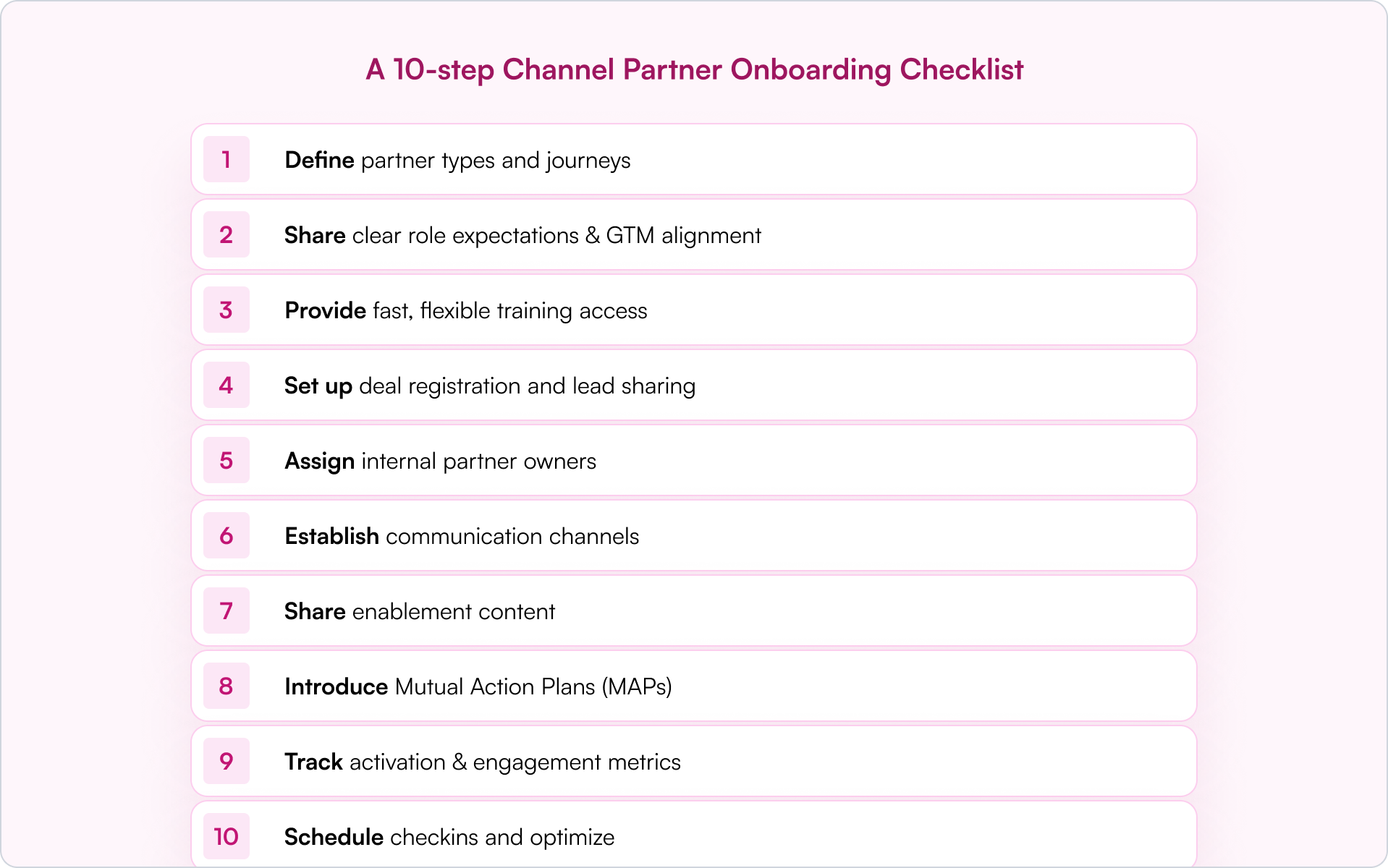
Step 1: Define Partner Types and Journeys
Every partner is different. This is especially true in regard to partner types.
Referral partners are not the same as reseller partners, who are not the same as tech partners. Each has different goals, and thus, needs different onboarding workflows.
Before you do anything else, understand the partner types your SaaS company works with. Then map out an effective, repeatable journey for each.
Tools like Introw make this easy. Our platform has a no-code flow builder that will help you quickly customize onboarding workflows based on partner types. Just as important, Introw includes automation features to streamline engagement.
Step 2: Share Clear Role Expectations & GTM Alignment
What do you want your partners to actually do?
Should they generate leads for your company's sales team? Should they work with your sales reps to walk prospects through the entire sales process? Should they sell independently via affiliate links? There are plenty of options.
Once you define partner roles, set timelines and key milestones. This will help you monitor partner progress and evaluate partner performance in an objective way.
Note: you don't have to set roles, timelines, and milestones for individual partners in your partner program. Instead, aim to define these things for each partner type.
Step 3: Provide Fast, Flexible Training Access
The best partner onboarding programs include effective training materials.
This begs the question, "What does effective partner training look like?" Simple: effective partner training is bite-sized, asynchronous, and easily trackable.
- Bite-Sized: Your partners don't have time for manuals or lengthy videos. Your training materials need to deliver quality information fast.
- Asynchronous: Your partners have busy schedules. Asking them to attend training at specific times is unrealistic. Your training materials should be asynchronous so partners can consume content when they have time.
- Trackable: Your partners are easily distracted. Your training materials should be trackable. That way you always know where they are in the training process and can keep them on track. This will ensure mutual success.
You might be wondering, "How do I deliver all these training materials?" There are multiple ways, but tools like Introw allow you to store and deliver content at scale. You can also invest in a full-fledged learning management system (LMS) if needed.
One more thing: Avoid gated content at all costs. Your partners aren't leads. Asking them for contact details in exchange for content will only lead to frustration.
Step 4: Set Up Deal Registration and Lead Sharing
Your partners are trained and ready to make sales. Now what?
Now you need to set up deal registration and lead sharing processes. If you don't, your partners won't be able to fill your pipeline with prospects or generate sales.
Every partner that goes through your SaaS company's onboarding process should know exactly how to submit leads, register deals, and receive feedback quickly.
With Introw, users can connect deal registration procedures directly with their Salesforce or HubSpot accounts, which will then provide them with real-time alerts. Introw is also equipped with AI to handle conflict resolution quickly and effectively.
Step 5: Assign Internal Partner Owners
Quick suggestion: take partner relationship management seriously.
How does this apply to the partner onboarding process? Ensure partners have clear points of contact within your SaaS company. Someone they can easily reach out to for advice, product information, and the occasional bit of encouragement
This will lead to better outcomes. Your partners will get the data they need to close deals. And your company will benefit from the revenue said partners generate.
Step 6: Establish Communication Channels
How will you communicate with your partners?
You could handle all partner questions via email. Or create a dedicated Slack channel to share updates. Or invest in some kind of company intranet tool.
As long as your chosen channel is easy for partners and channel managers to use - and allows for asynchronous communication—you should be good to go.
Introw was built with effective communication in mind. Our platform integrates with Slack and replies are auto-synced with Salesforce or HubSpot - no login required.
Step 7: Share Enablement Content
Make sure every partner has access to enablement content within their dedicated partner portal. We're talking about product docs, pitch decks, and case studies.
These materials will help your partners educate customers, make sales, and drive revenue for your SaaS company. As such, they're essential to partner performance.
In an ideal world, your enablement content will be tailored to specific use cases, regions, and/or products. This will make it easier for partners to use the right materials at the right times. The result? Greater business growth. Win!
Step 8: Introduce Mutual Action Plans (MAPs)
We asked you to consider goals and timelines in "Step 2" of this partner onboarding checklist. Now it's time to pursue those goals via mutual action plans.
A mutual action plan, sometimes referred to as a MAP, is a document that describes how you and your partners will achieve specific objectives in a systematic way.
Work with partners to determine goals, steps to accomplish them, and expected timelines. That way you're all on the same page and can pursue objectives together.
Introw users can access MAPS directly inside their Salesforce or HubSpot accounts, which ensures visibility for all parties and promotes strong collaboration.
Step 9: Track Activation & Engagement Metrics
You have to track metrics to build an effective partner onboarding program. The question is, which metrics should you track. Here are the most important ones:
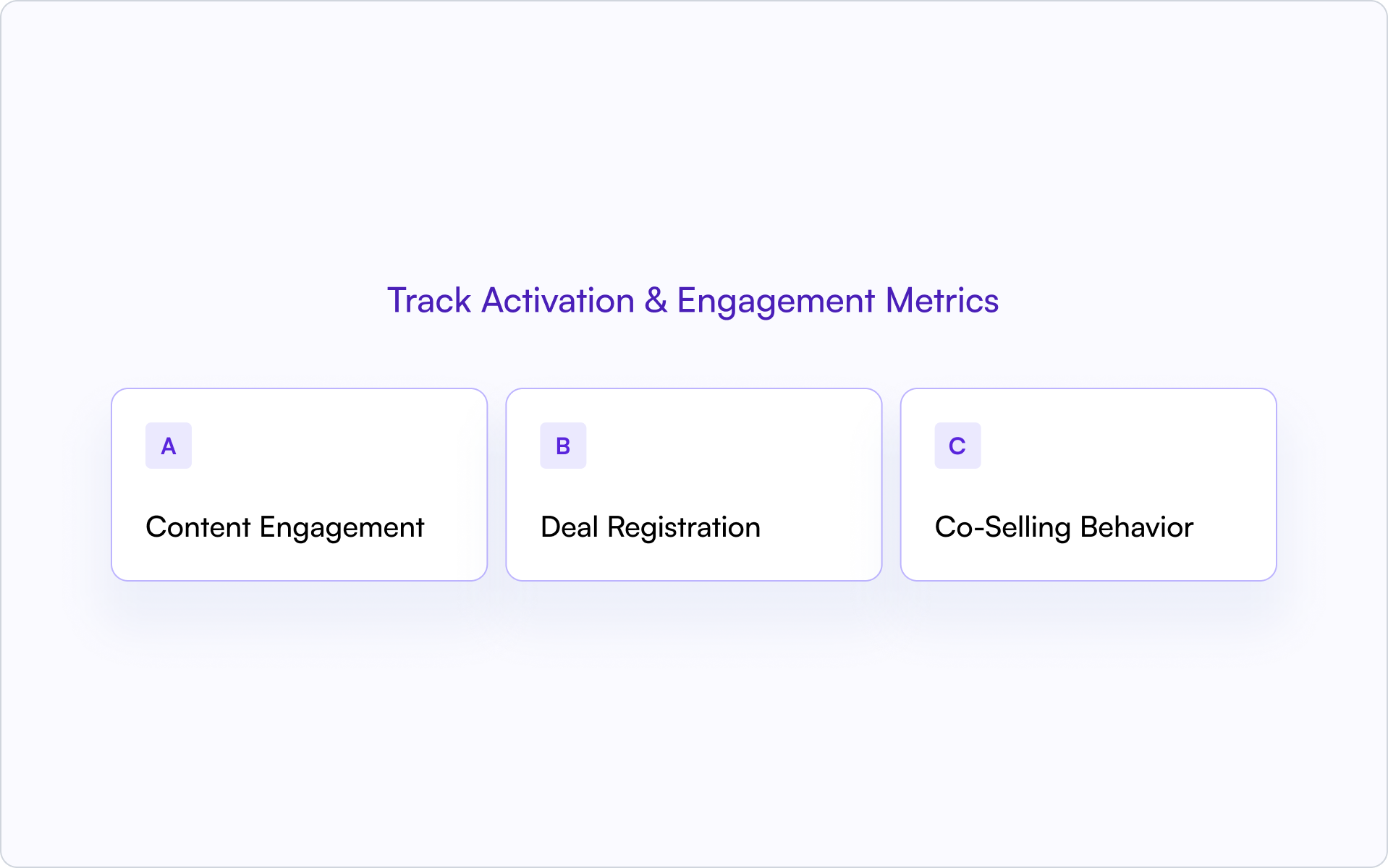
- Content Engagement: Has the partner completed the necessary training courses? Have they viewed your enablement content? Top performing partners know these things lead to more sales and success.
- Deal Registration: How many deals has the partner registered? At the end of the day, partner success is determined by revenue generated. The more each partner drives, the better—for them and your SaaS company.
- Co-Selling Behavior: Are your partners open to co-selling opportunities? Co-selling is a proven way to close deals at a consistent clip. The best partners take advantage to hit their sales targets on a regular basis.
Also worth mentioning, logins do NOT equal success.
You want partners to consume training programs, engage with your enablement content, and register new deals. Simply logging in to your partner portal doesn't drive revenue. As such, the metric doesn't signal a successful partner.
Step 10: Schedule Checkins and Optimize
Finally, schedule ongoing meetings with every partner.
These regular checkins will give you the chance to evaluate partner pipeline, assess partner progress toward goals, and educate partners to ensure future success.
We suggest 30, 60, and 90 day checkins with new partners. That way you can address questions, offer advice, and otherwise make sure your partners have a solid foundation. After 90 days, schedule quarterly business reviews (QBRs) instead.
You should consider incentive programs as well. This will encourage partners to work harder, which will only help to improve your partner program.
The Tech Stack You Need to Automate and Scale Partner Onboarding
As you might expect, the right tech stack can make all the difference when building a strong partner onboarding process. But which platform should you choose for your SaaS company? Look for a tech stack that offers:
- A CRM-Native Setup: Make sure your tech stack connects seamlessly to your CRM. That way you don't have to manually transfer data between systems.
- Off-Portal Collaboration: Make sure your platform allows you to interact with partners outside of the portal. This will reduce frustration for partners.
- No-Code Workflows: Make sure your tool is no-code. That way your team can build new partner workflows in a flash, even if they can't write code.
- Partner Engagement Tracking: Make sure your tech stack allows you to track partner engagement metrics. This will help you evaluate and optimize performance.
- Modular Partner Flows: Make sure your platform lets you easily customize partner workflows. That way you can tailor each one to a different partner type.
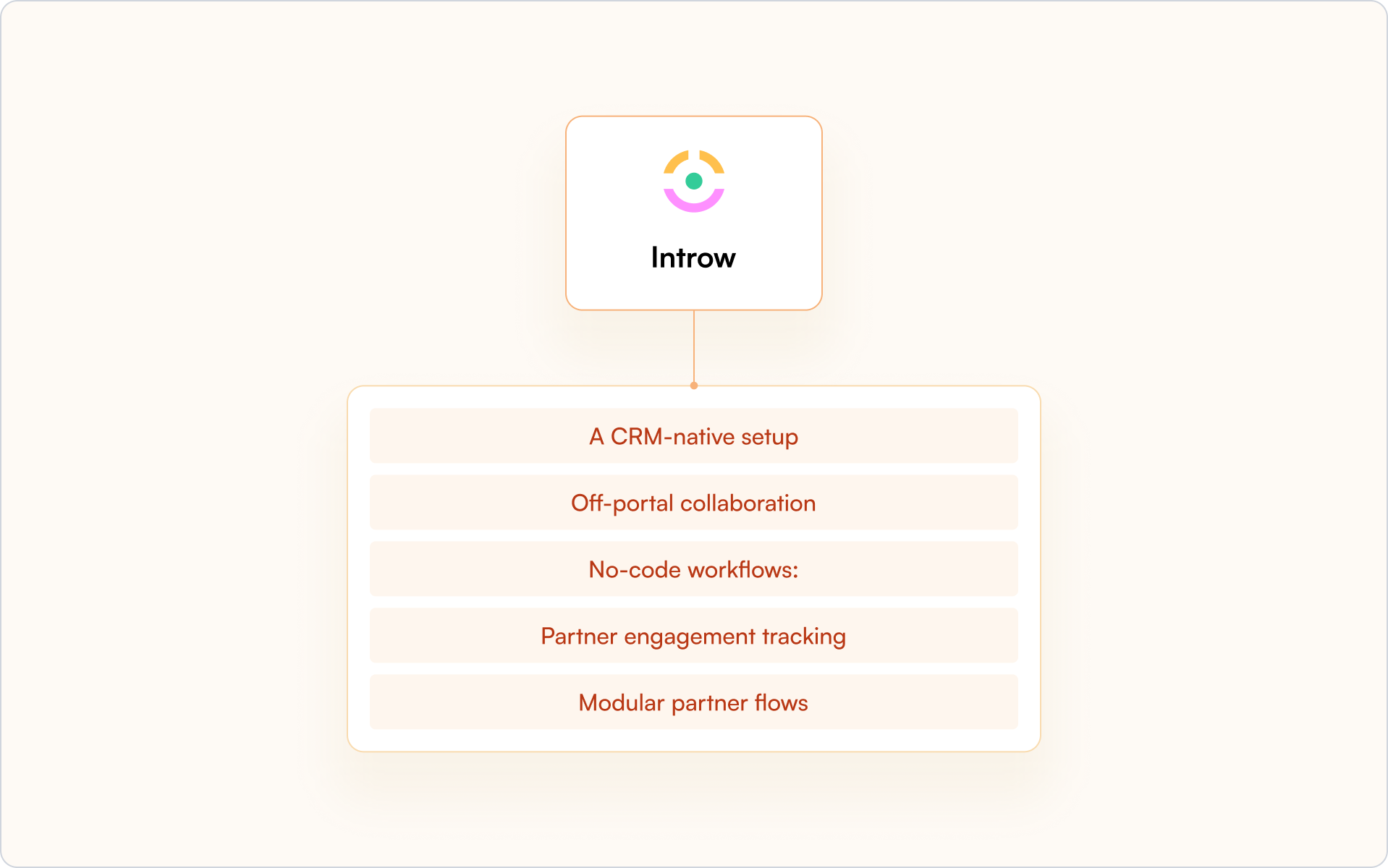
Introw was purpose-built for partner onboarding in 2026.
Our platform integrates perfectly with Salesforce and HubSpot, allows for off-portal collaboration, and includes important partner engagement metrics.
It's also no-code, so you can design custom workflows for every partner type. And you can do it in minutes, even if you've never coded before.
Sign up for a free demo today to see if Introw is right for your SaaS company.
Final Thoughts: Your Onboarding Checklist = Your Partner’s Launchpad
An effective channel partner onboarding process is essential in 2026.
Without one, your partners won't have the information and support they need to generate leads and close deals. This is why so many partner programs fail.
After reading this article, you know exactly how to build an effective partner onboarding process. Just as important, you know what to look for in a partner onboarding tool. Combined, this knowledge will help you grow profits via partners.
10 Best Practices for Channel Management: Proven Strategies to Grow Partner Revenue
Channel management isn’t about working harder — it’s about managing smarter. Whether you're scaling across indirect sales channels, empowering your channel partners, or optimizing your partner network, the right strategy makes all the difference.
A strong channel management strategy helps you align your business objectives with the partners that can move your product, expand your reach, and grow your bottom line. But without clarity and consistency, you’ll run into channel conflict, poor visibility, and disengaged partners — all of which stall growth.
This guide outlines 10 proven best practices to help you elevate your channel management efforts, improve partner performance, and build a more efficient, scalable revenue engine.
From setting clear goals and automating workflows to improving communication and analyzing channel performance, these strategies are designed for channel managers ready to win in today’s complex, multi-partner landscape.
What is Channel Management?
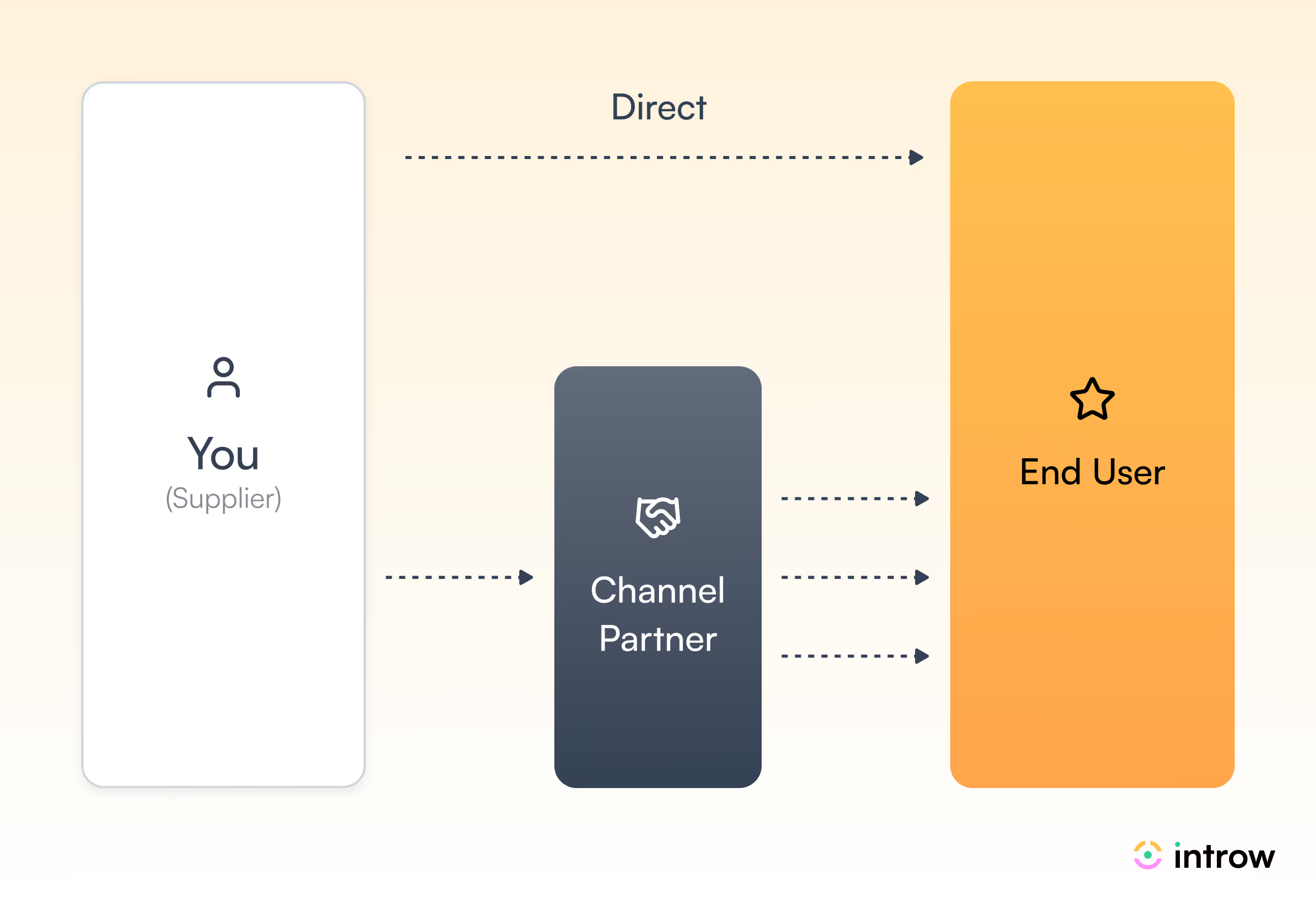
Before you can optimize your partner strategy, you need a clear understanding of what channel management really means — and why it’s essential for sustainable business growth.
Most companies rely on a mix of direct sales and indirect sales channels to reach their target customers. But as your business scales, juggling multiple sales channels without a clear system creates confusion, misalignment, and missed revenue.
That’s where effective channel management comes in — the foundation for building, maintaining, and scaling strong partner relationships.
Let’s break it down.
A channel is more than just a system — it’s your gateway to delivering products and services to the end customer.
Going through direct channels means your sales team handles every touchpoint: prospecting, selling, servicing, and supporting. It’s personal — but hard to scale.
By contrast, channel partners — like resellers, distributors, affiliates, and even e-commerce platforms — extend your reach through distribution channels you couldn’t access alone.
Think of it like this: Instead of selling toothpaste tube by tube, you sell an entire pallet to a retailer who handles the rest. In the SaaS world, channel partners introduce your product into networks and customer segments you haven’t penetrated yet.
Channel management refers to the systems and processes you use for managing relationships with the partners who sell, support, or promote your offering to the market.
A solid channel management strategy ensures these relationships are aligned with your business goals, supported with the right tools and training, and optimized for long-term performance. In short: it’s the blueprint for scalable, profitable growth through partners.
Common Challenges in Channel Management
Even the most promising channel strategy can fall short without a solid foundation. Many companies enter partnerships with the best intentions, only to find themselves facing roadblocks that stall channel performance and hurt business growth.
Whether you're just starting out or managing a mature partner network, it’s critical to understand the most common friction points and how they impact your results.
Here are four challenges that often derail effective channel management:
1. Lack of Alignment
A SaaS company partners with resellers but doesn’t align on sales targets or target customer profiles. The result? Conflicting priorities, overlapping efforts, and missed revenue opportunities.
2. Inconsistent Communication
A SaaS provider launches a major product update but only notifies a few partners. Others remain in the dark, unable to update marketing materials or support end customers, causing confusion and delays.
3. Poor Feedback Loop
New features are rolled out, but partner feedback is never collected. Valuable frontline insights are lost, resulting in lower adoption and features that don’t resonate with users.
4. Inadequate Training
Partners are onboarded quickly but without proper enablement. Without a clear understanding of the product, value props, and sales tools, they struggle to convert leads and support customers.
Each of these issues stems from one core problem: poor relationship management. And the impact is real — misalignment, inefficiencies, and channel conflict that erodes trust and slows momentum.
The good news? Every one of these challenges is fixable.
The right channel management tools can eliminate inefficiencies, increase partner performance, and ensure your channel management efforts are aligned with your most important business objectives.
Tools like Introw give you full visibility into your partner ecosystem — from onboarding to enablement to deal tracking. By reducing knowledge gaps and increasing accountability, you empower partners to succeed and scale faster.
So how do you move from reactive to strategic?
You start by optimizing every stage of the channel management process — from recruitment to retention.
In the next section, we’ll break down the 10 best practices that define a high-performance channel management strategy.
Optimize Every Stage of Channel Management with Modern PRM Tools
Mastering channel management means taking a lifecycle approach to your partner program — from recruitment and onboarding to co-selling and expansion. Each phase plays a critical role in achieving alignment, improving partner performance, and scaling revenue.
Modern channel management software like Introw enables this end-to-end orchestration. With seamless CRM integration, real-time deal tracking, and partner-friendly collaboration tools, you can support your entire partner network without friction.
Unlike outdated tools or spreadsheets, Introw aligns your channel managers, direct sales team, and indirect sales channels under one unified platform — so you can analyze channel performance, manage distribution partners, and grow revenue faster.
Let’s walk through the 10 key practices that define a high-performing channel management strategy, and how tools like Introw help you implement them across multiple sales channels:
1. Define Clear Channel Goals
If you want your channel programs to thrive, clarity is non-negotiable. Your channel partners need to understand exactly what you aim to achieve from the collaboration — and you should be clear on the value you’re delivering in return.
To execute a successful channel, start with measurable objectives tied to your business goals — such as growing a specific customer segment, launching in a new market, or improving customer satisfaction.
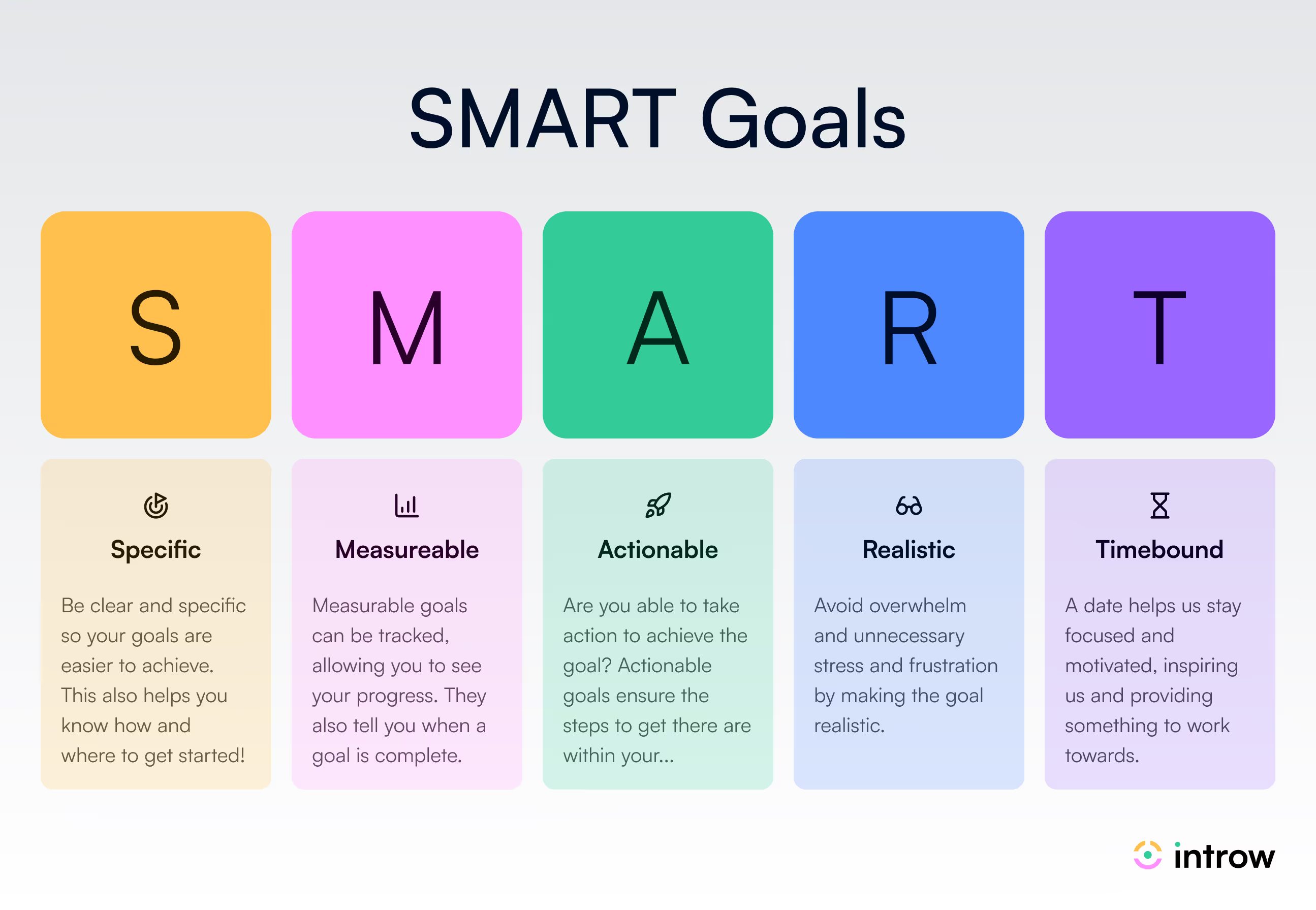
That’s where PRM platforms like Introw come in.
Introw transforms SMART goals into trackable metrics — like referral rates, sales process efficiency, and campaign impact — and visualizes them in real-time dashboards. This makes it easy for channel managers to track progress and optimize faster.
With automated KPIs and clear visibility, your channel strategy stays aligned across teams and partners.
2. Choose the Right Partners
When it comes to building a high-performance partner network, quality always beats quantity.
Too many companies take a "more is better" approach, signing dozens of channel partners without clear alignment. The result? Mixed priorities, missed revenue, and constant channel conflict.
Instead, focus your channel management efforts on a select group of high-impact partners:
- Partners who align with your business objectives and target customers
- Organizations that bring complementary reach, technology, or expertise
- Teams that can scale alongside your growth in multiple channels
Introw helps channel managers identify these high-potential fits through partner profiling, CRM overlap analysis, and visibility into historical engagement.
Pro tip: Use Introw’s native Crossbeam integration to discover partner overlaps, shared accounts, and warm intro paths — so you invest in partners that can actually move the needle.
And don’t forget to evaluate:
- Willingness to Invest: Are they engaged in joint planning, marketing strategy, or co-selling?
- Ability to Scale: Can they grow with you across new markets and distribution channels?
- Complementary Strengths: Do they unlock access to underserved customer segments or fill a technical gap?
A partner with a proven track record, strong internal enablement, and enthusiasm for collaboration is more valuable than ten who just want portal access.
3. Invest in Partner Onboarding
Initial onboarding isn’t just a checklist — it’s the foundation for long-term partner relationships and sales growth.
When channel management involves proper onboarding, partners:
- Understand your product positioning
- Get trained on your sales tools and ICP
- Learn how to represent your brand effectively in-market
Introw’s partner onboarding tools eliminate manual overhead with:
- Streamlined approval flows and digital agreements
- Auto-triggered welcome sequences and training checklists
- CRM-integrated training progress tracking
Your channel management software should reduce time-to-productivity and drive early wins.
With Introw, you can:
- Deliver custom content per partner tier or type
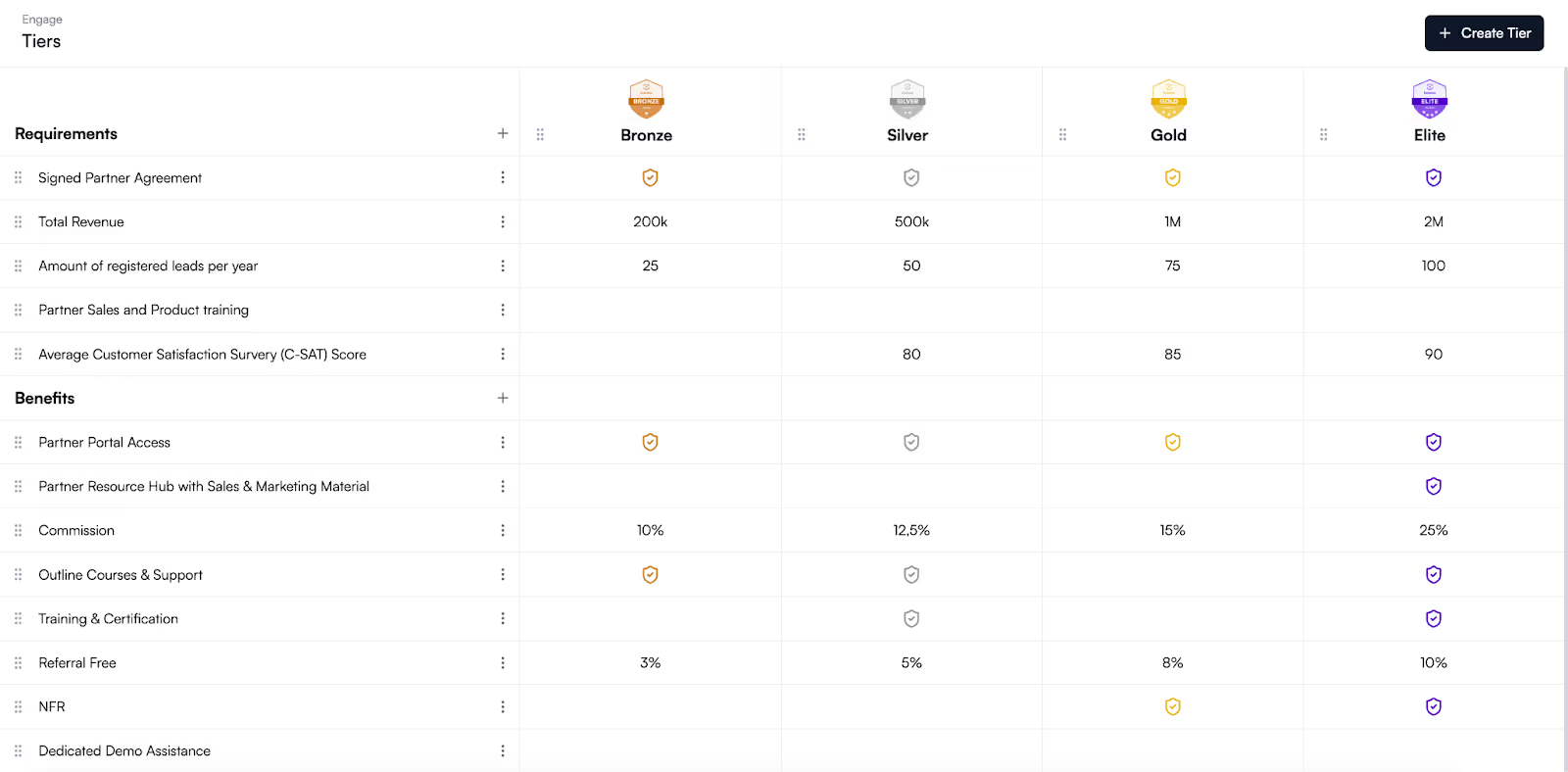
- Issue certifications for completed courses
- Track onboarding completion right from your CRM system
Because effective channel management ensures every partner gets the support they need — without overloading your internal teams.
4. Master Channel Management with a PRM Tool
Once your onboarding foundation is in place, the next step is to unify your ecosystem. That’s where a purpose-built PRM tool becomes essential to every aspect of your channel management strategy.
While traditional systems struggle to connect your sales channels, partner relationships, and real-time metrics, a modern solution like Introw brings them all together in one interface.
With Introw, you:
- Eliminate data silos across CRM systems, spreadsheets, and email threads
- Track deals, accounts, and partner activity in one place
- Enable cross-functional visibility between your direct sales channels and indirect sales teams
Introw’s CRM-native approach means you don’t have to switch tabs or train partners on new software. Instead, you get a lightweight experience that works through tools your teams already use — like Slack, Gmail, Salesforce, and HubSpot.
This integration enables:
- Real-time alerts when a deal is touched
- Shared dashboards to monitor channel performance
- Actionable insights for analyzing channel performance and resolving gaps
By giving both internal teams and channel partners access to centralized, real-time data, you reduce friction, improve accountability, and enable a more consistent customer experience.
Introw isn’t just the right tool — it’s the right channel management software for modern B2B teams who want faster execution, smarter collaboration, and measurable sales growth.
Let’s now explore how automation helps scale those results even further — while eliminating one of the biggest pain points: channel conflict.
5. Automate Manual Processes to Prevent Channel Conflict
Even the most aligned partner ecosystems face operational friction. Manual processes — like deal registration, email follow-ups, or lead assignment — often lead to miscommunication, duplication, and channel conflict.
Without automation, channel managers waste hours chasing updates or resolving disputes between distribution partners. And worse — deals fall through the cracks.
Introw automates the complexity so your team can stay focused on driving results. Here’s how:
- Deal Registration Automation: Prevent duplicate entries by flagging overlaps in real time across your CRM systems.
- Auto-Synced Workflows: Trigger follow-ups, assign tasks, or escalate conflicts automatically — no manual coordination required.
- Real-Time Notifications: Notify sales reps or channel partners immediately when a deal progresses or a task is completed.
By streamlining these core workflows, you reduce errors, improve sales performance, and maintain trust across your partner network.
6. Enhance Partner Communication
Strong partner relationships are built on clear, consistent communication. But too often, partner comms are scattered across emails, Slack messages, and outdated dashboards.
A unified system — like Introw — brings it all together.
With Introw, you can:
- Sync messaging across your CRM system, Slack, and email
- Share updates on campaigns, product changes, or marketing materials in real time
- Create account-specific channels for seamless collaboration between internal and external teams
This centralized visibility keeps your sales channels aligned and your channel strategy moving forward.
Plus, with integrated customer data and deal timelines, your channel partners never miss a beat — and your end customers get a smoother, more informed buying experience.
7. Create Regular Training Programs
Great partners aren’t found — they’re developed. Ongoing enablement is a critical pillar of effective channel management.
Whether you’re onboarding new MSPs, resellers, or VARs, your training should cover:
- Product updates and positioning
- Competitive landscape and market trends
- Use cases by customer segment and industry
- Sales tactics, pricing strategies, and objection handling
With Introw:
- Launch and manage certification programs by partner tier
- Track completion through embedded quizzes and progress dashboards
- Deliver content in multiple formats — PDFs, videos, Google Docs — all within one branded partner portal
This keeps your channel programs scalable and your partner performance consistent across various sales channels.
8. Incentivize and Reward High Performance
Nothing accelerates channel sales like the right incentives. And nothing derails it faster than unclear or delayed payouts.
High-performing channel partners want transparency and trust — and channel managers need a scalable system to track it all.
With Introw:
- Set up tiered commission structures or SPIFs
- Track revenue attribution by partner, territory, or campaign
- Automate payout reporting and eligibility reminders
You can even integrate partner performance data with your CRM system or finance tool to eliminate manual calculations and ensure every reward is backed by real-time numbers.
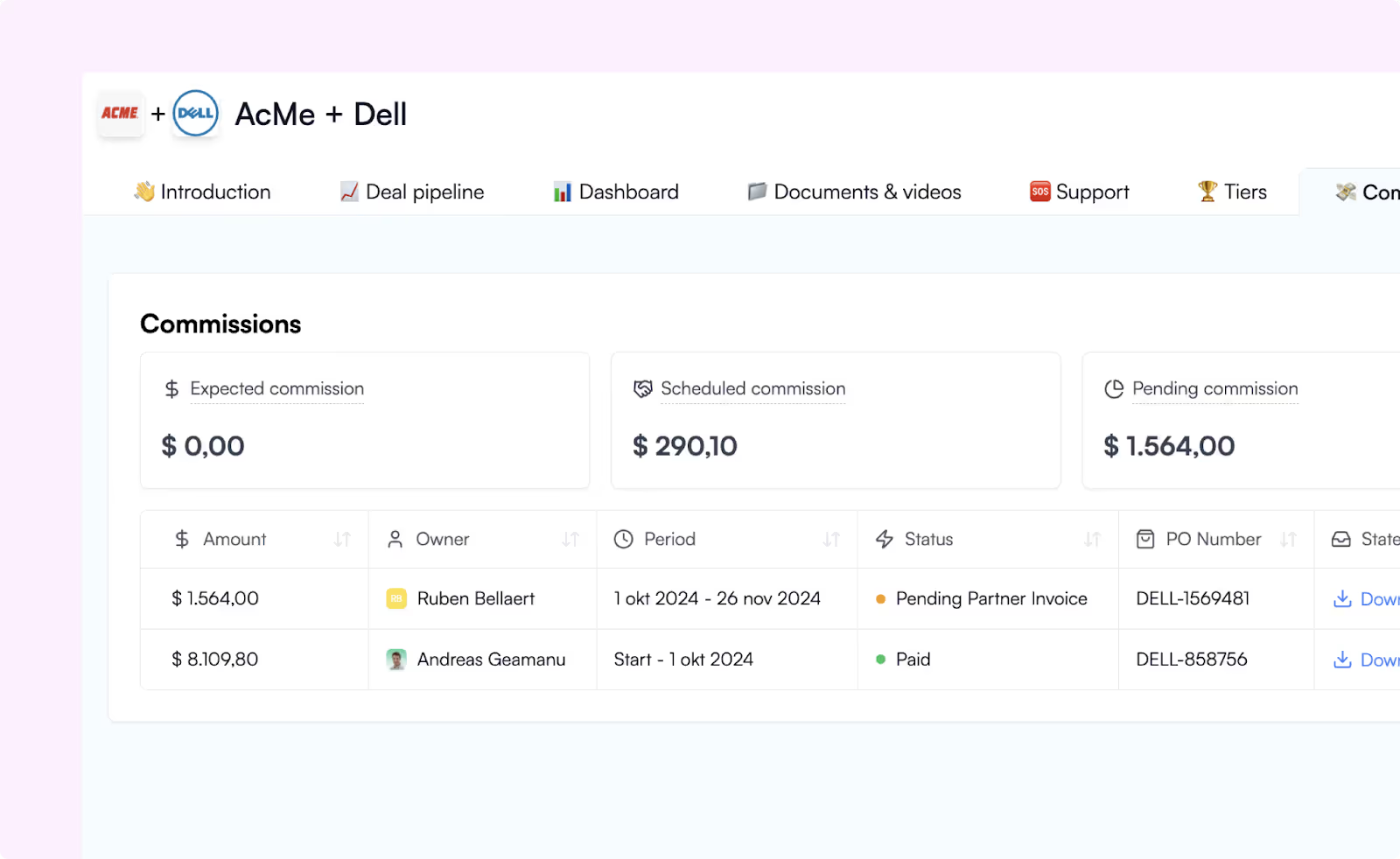
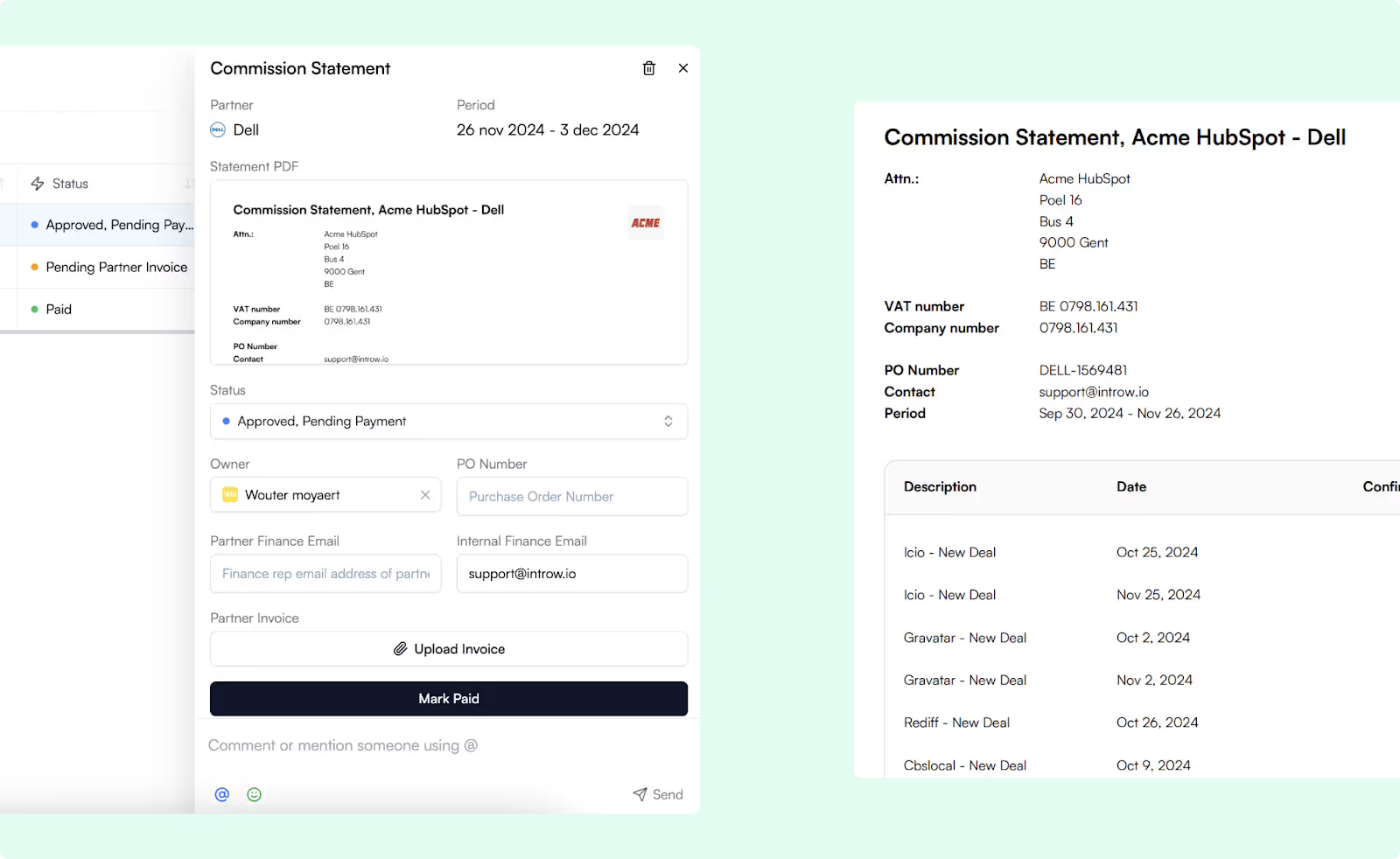
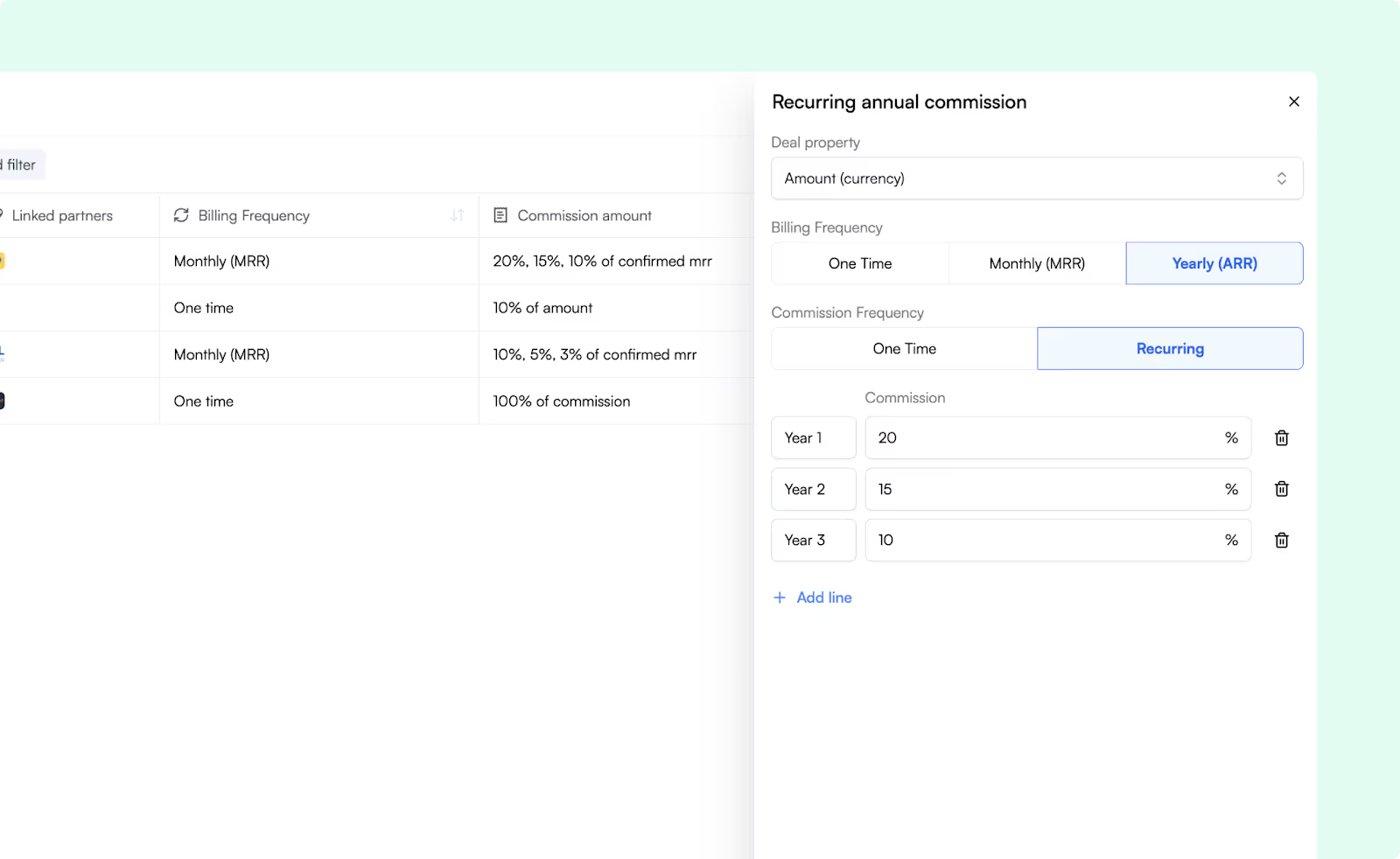
This keeps motivation high, reduces disputes, and turns your partner program into a powerful sales engine.
9. Monitor Performance and Deliver Feedback
To continuously improve your channel management strategy, you need visibility. Not just into revenue — but into deal velocity, campaign engagement, and partner health.
Introw’s reporting engine makes it easy to:
- Set key performance indicators (KPIs) by partner type
- Analyze contribution to pipeline and close rate
- Identify underperforming regions or partners at risk
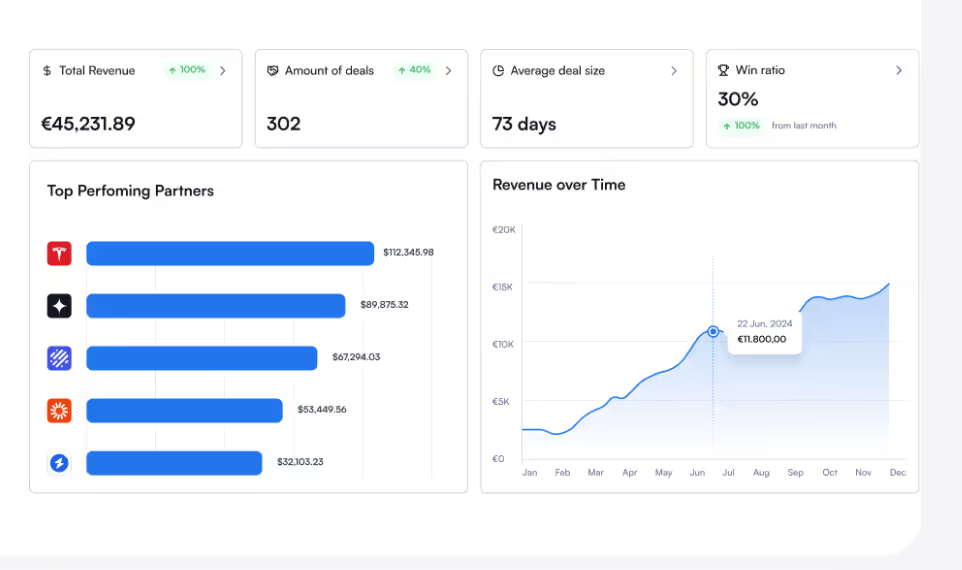
More importantly, it enables ongoing support — through automated feedback loops, QBRs, and personalized coaching plans.
Because channel management involves more than just metrics — it’s about managing relationships that fuel long-term business growth.
10. Amplify Success Through Channel Marketing and Co-Marketing
Finally, even the best partnerships can stall without marketing support. Your partners need assets, guidance, and budget to drive demand — and you need visibility into what’s working.
A modern channel campaign management approach includes:
- Co-branded email and ad templates
- Social content tailored to customer preferences
- Campaign tracking tied to lead generation or revenue
With Introw:
- Share approved messaging and assets in your partner portal
- Track campaign adoption and outcomes by region or partner
- Collect insights that help you optimize your marketing strategy across the ecosystem
Co-marketing isn’t a nice-to-have — it’s a growth multiplier. With Introw, you can turn co-marketing from ad hoc to always-on.
Conclusion
Without effective channel management, even the best partner programs stall. If your strategy isn’t aligned, automated, and data-driven — you’re leaving revenue on the table.
A modern channel management strategy requires clear goals, the right partners, a frictionless onboarding experience, and consistent training and communication. But most importantly, it needs a system that scales.
That’s where Introw comes in.
With Introw, channel managers can:
- Eliminate manual workflows and reduce channel conflict
- Improve visibility across multiple sales channels and partner types
- Automate onboarding, training, deal tracking, and performance reporting
- Support better partner relationships with real-time CRM insights
- Track and analyze channel performance and drive revenue growth
Whether you’re running a mature channel sales strategy or just starting to scale with indirect sales channels, Introw gives you the right channel management software to move faster, stay aligned, and grow with confidence.
Ready to turn your partner ecosystem into a high-performing revenue machine?


.svg)



















